Welcome to the ultimate Italy Trip Planner for adventurers, foodies, history buffs, and culture enthusiasts alike. From the romantic canals of Venice to the ancient ruins of Rome, Italy captivates visitors with its extraordinary blend of artistic masterpieces, historical treasures, and unparalleled culinary delights.
Italy’s remarkable diversity means you can ski in the Alps, sunbathe on Mediterranean beaches, explore medieval hill towns, and marvel at Renaissance art all within the same country. This enchanting destination offers experiences for every type of traveler, whether you’re seeking luxury, adventure, cultural immersion, or simply the perfect plate of pasta.
Italy’s artistic heritage remains a primary draw for travelers. Museums like the Uffizi Gallery, Vatican Museums, and Borghese Gallery house incomparable collections featuring works by Michelangelo, Leonardo da Vinci, Raphael, Caravaggio, and countless other masters. Beyond museums, art permeates public spaces, churches, and palaces throughout the country.
The diversity of Italy’s landscapes contributes significantly to its tourism appeal. Travelers can explore the dramatic Alpine scenery in the north, the rolling vine-covered hills of Tuscany and Umbria, the striking Amalfi Coast, and the sun-drenched beaches of Sicily and Sardinia. Each region offers distinctive natural beauty and outdoor recreational opportunities.
Italian cities each provide unique experiences. Rome blends ancient monuments with vibrant contemporary life. Venice enchants with its gondola-filled canals and Byzantine architecture. Florence preserves its Renaissance character. Milan combines historic sites with modern fashion and design. Naples offers authentic southern Italian energy and serves as a gateway to Pompeii and the Amalfi Coast.
Food and wine tourism has grown increasingly important, with visitors pursuing authentic culinary experiences across Italy’s diverse regional traditions. Cooking classes, vineyard tours, food markets, and regional specialties attract culinary enthusiasts seeking genuine connections to Italian gastronomy.
Key Facts About Italy
- Capital: Rome (Roma)
- Currency: Euro (€) – adopted in 1999 for financial transactions and in 2002 as physical currency, replacing the Italian Lira
- Official Language: Italian
- Bordering Countries:
- France (northwest)
- Switzerland (north)
- Austria (northeast)
- Slovenia (northeast)
- Vatican City (enclave within Rome)
- San Marino (enclave in north-central Italy)
- Land Area: Approximately 301,340 square kilometers (116,350 square miles)
- Population: About 60 million
- Government Type: Parliamentary Republic
- Head of State: President of the Republic
- Head of Government: Prime Minister (Presidente del Consiglio)
- Administrative Divisions: 20 regions, including 5 autonomous regions with special status
- Time Zone: Central European Time (CET/UTC+1); Central European Summer Time (CEST/UTC+2) during daylight saving
Best Places to visit in Italy
Rome
The Colosseum

The Colosseum (or Coliseum) is perhaps Rome’s most iconic landmark – an enormous amphitheater built between 70-80 CE during the Flavian dynasty. This massive stone structure could hold between 50,000-80,000 spectators who came to watch gladiatorial contests, animal hunts, executions, battle reenactments, and even mock naval battles when the arena was flooded.
The Colosseum represents the engineering prowess of ancient Rome and provides essential insights into Roman entertainment and social structure.
Location: Piazza del Colosseo, 1, 00184 Roma RM, Italy
Connectivity: By Metro:
- Line: Metro Line B.
- Station: Colosseo.
Vatican City

While technically an independent city-state, Vatican City sits within Rome and serves as the spiritual and administrative headquarters of the Roman Catholic Church.
At just 49 hectares (121 acres), it’s the world’s smallest sovereign state but contains immense cultural treasures including St. Peter’s Basilica, the Sistine Chapel with Michelangelo’s famous ceiling, and the Vatican Museums housing one of the world’s most significant art collections spanning thousands of years.
Connectivity: From Rome to Vatican City
By train:
Roma Termini → Roma S. Pietro
By Metro:
Metro Line-A to Ottaviano-S
Roman Forum

The Roman Forum was the beating heart of ancient Rome – the center of political, religious, commercial, and judicial life. This rectangular plaza surrounded by the ruins of important government buildings served as the venue for public speeches, elections, criminal trials, commercial affairs, and religious ceremonies.
Walking through the Roman Forum today allows visitors to step back in time to when Rome was the center of Western civilization.
Connectivity: By Metro:
- Line: Metro Line B.
- Station: Colosseo.
By Bus:
Numbers 64 & 75
Station: Roma Termini -> “Fori Imperiali/Campidoglio”
Trevi Fountain

This magnificent Baroque fountain completed in 1762 is one of the largest and most spectacular fountains in the world. The central figure depicts Neptune, god of the sea, flanked by tritons.
The tradition of throwing a coin into the fountain (right hand over left shoulder) is said to ensure a return visit to Rome. The fountain collects approximately €1.5 million annually, which is donated to charity.
Connectivity: By Metro:
- Line: Metro Line A.
- Station: Barberini-Fontana di Trevi .
By Bus:
- Numbers 64
- Station: Roma Termini -> Nazionale/Palazzo Esposizioni
- Number: 71
- Station: panisperna -> tritone/fontana trevi
Pantheon

One of ancient Rome’s best-preserved buildings, the Pantheon was built around 126 CE during Emperor Hadrian’s reign. Its perfect proportions (the height of the dome equals the diameter of the interior circle) and remarkable engineering make it an architectural marvel.
The name comes from Greek words meaning “honor all gods,” reflecting its original purpose as a temple. The oculus, an opening at the top of the dome, is the building’s only source of natural light and creates a moving spotlight effect throughout the day.
Address: Piazza della Rotonda, 00186 Rome, Italy
Connectivity:
By Metro:
- Line: Metro Line A.
- Station: Barberini station.
By Tram:
- Line: Metro Line 8.
- Station: Piazza Venezia.
By Bus:
- Line: 64, 30, 70, 81, 87, 62, 83, 85, 160, 492, 40, 60 and 628.
- Station: Corso – Minghetti, Corso Rinascimento, Largo di Torre Argentina.
Borghese Gallery

Housed in the former Villa Borghese Pinciana, this art gallery contains a substantial collection of paintings, sculptures, and antiquities begun by Cardinal Scipione Borghese in the 17th century.
The collection includes masterpieces by Bernini, Caravaggio, Raphael, and Titian. The gallery is surrounded by beautiful gardens that form one of Rome’s largest public parks.
Address: Piazzale del Museo Borghese, 5, 00197 Roma RM, Italy
Connectivity:
By Metro:
- Line: Metro Line A.
- Station: Spagna Metro Station or Barberini Metro Station
By Bus:
- Line: 910, 92, 89, 490, 495, 61, 160, 63, 83, 52, and 53.
- Station: Pinciana/Museo Borghese or S.Paolo del Brasile stop
Parking:
If you are driving, you can park at Parcheggio Saba Villa Borghese, a 3-minute walk from the museum
Castel Sant’Angelo

Originally built as a mausoleum for Emperor Hadrian and his family (123-139 CE), this cylindrical building later served as a fortress, castle, papal residence, and prison. A secret corridor (Passetto di Borgo) connects it to Vatican City, providing popes with an escape route during times of danger. Today it houses a museum with collections of paintings, military memorabilia, medieval firearms, and sculptures.
Address: Castel Sant’Angelo, Lungotevere Castello, 50, 00193 Roma RM, Italy
Connectivity:
By Metro:
- Line: Metro Line A.
- Station: Lepanto (approximately a 17-minute walk) or Ottaviano
By Bus:
- Line: 23, 40, 280, 62, 64, and 982
- Station: Lgt Tor Di Nona/Rondinella (a 4-minute walk)
By Train:
- Lines: FL3 and FL5
- Station: Roma San Pietro (about 22 minutes away)
St. Peter’s Basilica

One of Christianity’s holiest sites and an extraordinary achievement of Renaissance architecture, St. Peter’s Basilica was built over what is traditionally considered to be the burial site of St. Peter, one of Jesus’s apostles and the first Pope.
The current basilica, completed in 1626, features works by many renowned artists including Michelangelo’s Pietà sculpture and his design for the magnificent dome. The interior is breathtaking in scale and decoration.
Address: Piazza San Pietro, 00120 Città del Vaticano, Vatican City
Connectivity:
By Metro:
- Line: Metro Line A.
- Station: Ottaviano-S
By Bus:
- Line: 64, 32,81, 982
- Station: Via di Porta Cavalleggeri, Piazza del Risorgimento(about 10 minutes away)
By Train:
Station: Roma San Pietro station
Palatine Hill

One of Rome’s seven hills, the Palatine occupies a central position overlooking the Roman Forum on one side and the Circus Maximus on the other. According to Roman mythology, this is where Romulus and Remus were found by the she-wolf, and where Romulus eventually founded the city in 753 BCE.
The hill became an exclusive residential area for Roman emperors and aristocracy, with extensive palaces and gardens whose ruins can still be explored today.
Address: 00186 Rome, Metropolitan City of Rome, Italy
Connectivity:
By Metro:
- Line: Metro Line B.
- Station: Colosseo station
By Bus:
- Line: 87, 85 and 51, 75, 81, 118.
- Station: Fori Imperiali/Campidoglio
By Tram:
- Line: Metro Line 3, 8.
- Station: Piazza del Colosseo station
Capuchin Crypt

Located beneath the church of Santa Maria della Concezione dei Cappuccini, this unusual site contains the skeletal remains of approximately 3,700 Capuchin friars arranged in elaborate decorative patterns. The bones form chandeliers, arches, and other ornamental displays across six small chapels.
Rather than being macabre, the crypt was designed as a profound reminder of human mortality and the swift passage of life on earth – a physical manifestation of the memento mori (“remember you must die”) tradition in Christianity.
Address: Via Vittorio Veneto, 27, 00187 Roma RM, Italy.
Connectivity:
By Metro:
- Line: Metro Line A.
- Station: Barberini
By Bus:
- Line: 52, 63, or 175
- Station: Barberini (ma)
Venice

Venice is truly one of the world’s most extraordinary cities—a place where streets are replaced by canals and where centuries of art, architecture, and history create an atmosphere unlike anywhere else. Let me walk you through the essential places to visit when exploring this remarkable floating city.
St. Mark’s Square (Piazza San Marco)

The heart of Venice, St. Mark’s Square represents the social, religious, and political center of Venetian life for centuries. Napoleon once called it “the drawing room of Europe,” and when you stand in this magnificent public space, you’ll understand why. The square is bordered by arcaded buildings and dominated by three major structures:
St. Mark’s Basilica is the crown jewel of the square—a masterpiece of Byzantine architecture completed in the 11th century. The church’s exterior features dramatic domes and intricate mosaics, while the interior glitters with gold mosaics covering over 8,000 square meters of wall and ceiling space. These tell biblical stories and Venetian histories, creating an atmosphere that feels both reverent and opulent.
The Campanile (bell tower) stands at 98.6 meters tall and offers one of the best panoramic views of Venice and its lagoon. What many visitors don’t realize is that the current tower is actually a reconstruction—the original collapsed suddenly in 1902, remarkably injuring only the caretaker’s cat.
Doge’s Palace (Palazzo Ducale) served as both the residence of the Doge (Venice’s elected leader) and the seat of government for the Venetian Republic. Its distinctive Gothic façade features a pattern of pink Verona marble and white Istrian stone. Inside, you’ll find lavishly decorated council chambers and the famous Bridge of Sighs, which connects the palace to the historic prison.
Connectivity:
Vaporetto (Water Bus):
- Station: Rialto stop: 1, 2, N.
- San Marco- Vallaresso: 1, 2, N.
- San Marco-San Zaccaria: 1, 2, 4.1, 4.2, 5.1, 5.2, 14, 20, N.
By Bus:
- Line:
- Station: wb flamingo after linq
Water Taxi:
- Alilaguna water bus: Blue Line to San Marco stop
Grand Canal

Venice’s main thoroughfare isn’t a street but a sinuous S-shaped waterway cutting through the heart of the city. A journey along the Grand Canal is like traveling through a living museum of architectural styles spanning nearly 1,000 years:
The best way to experience the canal is via vaporetto (water bus), particularly line #1, which travels the entire length making frequent stops. This gives you time to admire the parade of palaces lining both sides—from Byzantine and Gothic to Renaissance and Baroque. Each building tells a story of Venice’s wealthy merchant families who competed to build increasingly grand homes.
Rialto Bridge, the oldest and most famous of the four bridges spanning the Grand Canal, was completed in 1591. Its distinctive single marble arch supports two rows of shops and offers spectacular views of the bustling waterway below.
The Islands of the Venetian Lagoon

While the main city demands your attention, the surrounding lagoon islands offer fascinating glimpses into different aspects of Venetian culture:
Murano has been famous for its glass production since 1291, when all glass furnaces were moved from Venice proper due to fire concerns. Visiting a glass factory demonstration shows you the incredible skill that goes into creating Murano’s signature colorful glassware—a tradition passed down through generations of master craftsmen.
Burano is immediately recognizable by its brightly colored houses painted in various hues of pink, blue, green, and yellow. Legend claims this tradition began so fishermen could identify their homes through the lagoon fog. The island is also renowned for its delicate lace-making tradition, though few authentic practitioners remain today.
Torcello holds special significance as one of the earliest settled islands in the Venetian lagoon. Today it’s largely rural, but its magnificent Cathedral of Santa Maria Assunta contains spectacular Byzantine mosaics dating from the 11th and 12th centuries, including a haunting depiction of the Last Judgment.
Connectivity:
Murano
- Vaporetto lines: 4.1, 4.2, 12, 13 from Fondamente Nove
- Journey time: ~15 minutes from Fondamente Nove
- Nearby stations: Murano Colonna, Murano Faro, Murano Museo, Murano Navagero, Murano Venier
Burano
- Vaporetto lines: 12 from Fondamente Nove
- Journey time: ~45 minutes from Fondamente Nove
- Nearby stations: Burano (main stop), Mazzorbo (connected to Burano by bridge)
Torcello
- Vaporetto line: 12 from Fondamente Nove, then transfer at Burano to line 9
- Journey time: ~45 minutes to Burano, then 5 minutes to Torcello
- Nearby station: Torcello (single stop)
Lido
- Vaporetto lines: 1, 5.1, 5.2, 6, 10 from San Marco
- Journey time: ~15 minutes from San Marco
- Nearby stations: Lido Santa Maria Elisabetta (main stop), San Nicolò, Lido Casino
San Giorgio Maggiore
- Vaporetto line: 2 from San Marco-San Zaccaria
- Journey time: ~3 minutes from San Marco
- Nearby station: San Giorgio (single stop)
Giudecca
- Vaporetto lines: 2, 4.1, 4.2 from San Marco-San Zaccaria
- Journey time: ~5 minutes from San Marco
- Nearby stations: Palanca, Redentore, Zitelle
Key Departure Points:
- Fondamente Nove: Main departure point for Murano, Burano, and Torcello
- San Marco-San Zaccaria: Main departure point for Lido, San Giorgio Maggiore, and Giudecca
- Piazzale Roma: Connection point for buses to/from mainland
An ACTV vaporetto day pass (€20) is recommended if you plan to visit multiple islands in one day.
Venetian Art Treasures
The Gallerie dell’Accademia houses the most comprehensive collection of Venetian painting anywhere, spanning from Byzantine influences through the Renaissance to the 18th century. Here you’ll find masterpieces by Bellini, Titian, Tintoretto, Veronese, and Giorgione that showcase Venice’s distinctive painting style, known for its rich color and atmospheric effects.
Scuola Grande di San Rocco contains Tintoretto’s greatest achievement—a cycle of more than 50 paintings completed over 23 years. What makes this place special is experiencing these powerful works in situ, exactly where the artist intended them to be seen, with natural light changing their appearance throughout the day.
Peggy Guggenheim Collection offers an entirely different artistic experience, housed in the American heiress’s former home on the Grand Canal. This outstanding collection of 20th-century art includes works by Picasso, Kandinsky, Pollock, and Dalí, demonstrating how Venice has continued to inspire and house important art into the modern era.
Connectivity:
Gallerie dell’Accademia
- Location: Dorsoduro district
- Vaporetto: Line 1 or 2 to Accademia stop
- Nearby stations: Accademia, Salute, Zattere
Peggy Guggenheim Collection
- Location: Dorsoduro district
- Vaporetto: Line 1 to Salute stop
- Nearby stations: Salute, Accademia
Scuola Grande di San Rocco (Tintoretto masterpieces)
- Location: San Polo district
- Vaporetto: Line 1 to San Tomà stop
- Nearby stations: San Tomà, San Silvestro
Ca’ Rezzonico (Museum of 18th Century Venice)
- Location: Dorsoduro district
- Vaporetto: Line 1 to Ca’ Rezzonico stop
- Nearby stations: Ca’ Rezzonico, San Tomà
Ca’ Pesaro (Modern Art Museum)
- Location: Santa Croce district
- Vaporetto: Line 1 to San Stae stop
- Nearby stations: San Stae, Riva di Biasio
Palazzo Fortuny
- Location: San Marco district
- Vaporetto: Line 1 or 2 to Rialto stop
- Nearby stations: Rialto, San Silvestro
St. Mark’s Basilica Treasures & Mosaics
- Location: St. Mark’s Square
- Vaporetto: Lines 1, 2, N to San Marco-Vallaresso or San Marco-San Zaccaria
- Nearby stations: San Marco-Vallaresso, San Marco-San Zaccaria
Palazzo Ducale (Doge’s Palace)
- Location: St. Mark’s Square
- Vaporetto: Lines 1, 2, N to San Marco-San Zaccaria
- Nearby stations: San Marco-San Zaccaria, San Marco-Vallaresso
Punta della Dogana (Contemporary Art)
- Location: Dorsoduro district, at the tip
- Vaporetto: Line 1 to Salute stop
- Nearby stations: Salute, San Marco-San Zaccaria
Galleria Giorgio Franchetti alla Ca’ d’Oro
- Location: Cannaregio district
- Vaporetto: Line 1 to Ca’ d’Oro stop
- Nearby stations: Ca’ d’Oro, Rialto
Consider purchasing the Venice Museum Pass for access to multiple museums, or the Museum Pass + ACTV transport card combo for convenient travel between art destinations.
Milan

Milan represents Italy’s sophisticated, cosmopolitan side – a blend of historic grandeur and forward-thinking modernity that sets it apart from other Italian cities. While Rome celebrates its ancient past and Venice floats in timeless romance, Milan pulses with contemporary energy while still honoring its rich artistic heritage. Let me walk you through Milan’s essential experiences and why each matters.
The Duomo (Milan Cathedral)

Gothic masterpiece with 135 marble spires and 3,400 statues. Take the elevator to the rooftop for spectacular views of Milan and the distant Alps. The interior features massive pillars and beautiful stained glass windows.
Address: Piazza del Duomo, 20122 Milano MI, Italy
Connectivity:
By Metro:
- Duomo: Direct access (Lines M1, M3)
- San Babila: 5-minute walk (Line M1)
- Cordusio: 5-minute walk (Line M1)
- Missori: 5-minute walk (Line M3)
- Montenapoleone: 10-minute walk (Line M3)
By Bus:
- Line: 57, 60, 73, and B15
- Station: L.go Augusto
By Tram:
- Lines 2, 14: Stop at “Duomo” or “Torino”
- Line 24: Stop at “Duomo”
- Line 27: Stop at “Duomo”
The Last Supper (Il Cenacolo)

Leonardo da Vinci’s masterpiece at Santa Maria delle Grazie church. This iconic mural captures the moment Jesus announces his betrayal. Visits require reservations months in advance due to strict visitor limitations.
Connectivity:
By Metro:
- Line: 1, 3.
- Station: Conziliazone, Cadorno
By Bus:
- Line: 50, 169.
- Station: Boccaccio
By Tram:
- Line: 16
- Station: S. Maria delle Grazie
Galleria Vittorio Emanuele II

Italy’s oldest active shopping mall, characterized by its stunning glass dome roof and mosaic floors. Home to luxury boutiques, historic cafés, and the tradition of spinning on the bull mosaic for good luck.
Connectivity:
By Metro:
- Duomo: Direct access (Lines M1, M3)
- Cordusio: 3-minute walk (Line M1)
- San Babila: 7-minute walk (Line M1)
- Missori: 7-minute walk (Line M3)
- Montenapoleone: 10-minute walk (Line M3)
By Bus:
- Line: M2, M3
- Station: Via Larga.
By Tram:
- Lines 1, 2, 14: Stop at “Duomo” or “Via Torino”
- Line 24: Stop at “Duomo”
- Line 27: Stop at “Duomo”
Teatro alla Scala (La Scala Opera House)

World-renowned opera house opened in 1778. Visit the La Scala Museum to see theatrical memorabilia and possibly peek into the opulent red and gold theater when rehearsals aren’t underway.
Connectivity:
By Metro:
- Duomo: 5-minute walk (Lines M1, M3)
- Montenapoleone: 5-minute walk (Line M3)
- Cordusio: 7-minute walk (Line M1)
- Lanza: 10-minute walk (Line M2)
- Cairoli: 12-minute walk (Line M1)
By Bus:
- Line: 61, 57, 94
- Station: Piazza della Scala, Via Manzoni.
By Tram:
- Line 1: Stop at “Via Manzoni – Scala” (closest to the theater)
- Lines 2, 14: Stop at “Via Manzoni” or “Duomo”
- Line 4: Stop at “Via Verdi” (very close to the theater entrance)
Castello Sforzesco

Imposing Renaissance fortress housing several museums including art collections and Michelangelo’s final unfinished sculpture, the Rondanini Pietà. The castle grounds lead to Parco Sempione.
Connectivity:
By Metro:
- Cairoli: 250 meters (3-minute walk) – Line M1
- Cadorna FN: 650 meters (8-minute walk) – Lines M1, M2
- Lanza: 750 meters (9-minute walk) – Line M2
- Cordusio: 800 meters (10-minute walk) – Line M1
- Moscova: 900 meters (11-minute walk) – Line M2
By Bus:
- Line 50: Stop at “Cairoli M1”
- Line 57: Stop at “Cairoli M1”
- Line 94: Stop at “Cadorna”
- Line 58: Stop at “Lanza M2”
By Tram:
- Lines 1, 4, 19: Stop at “Cairoli M1”
- Lines 2, 4, 12, 14: Stop at “Lanza M2”
- Lines 1, 10: Stop at “Cadorna”
Pinacoteca di Brera
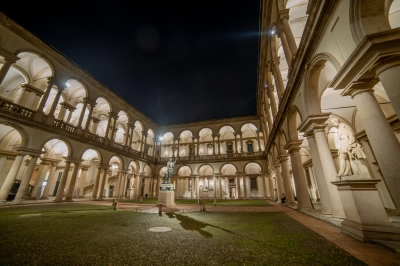
Premier art gallery featuring masterpieces from Northern Italian Renaissance and Baroque periods. Highlights include Mantegna’s “Dead Christ,” Raphael’s “Marriage of the Virgin,” and Hayez’s “The Kiss.”
Connectivity:
By Metro:
- Lanza: 500 meters (6-minute walk) – Line M2
- Montenapoleone: 700 meters (9-minute walk) – Line M3
- Cairoli: 800 meters (10-minute walk) – Line M1
- Moscova: 900 meters (11-minute walk) – Line M2
- Turati: 950 meters (12-minute walk) – Line M3
By Bus:
- Line 57: Stop at “Foro Buonaparte – Cusani”
- Line 61: Stop at “Via Pontaccio”
- Line 94: Stop at “Via Cusani”
By Tram:
- Lines 1, 12, 14: Stop at “Via Cusani – Lanza M2”
- Line 2: Stop at “Via Brera”
- Line 4: Stop at “Via Ponte Vetero”
Navigli District

Milan’s canal district offers a contrasting atmosphere to the city center. Home to vibrant nightlife, antique markets, art galleries, and countless restaurants serving aperitivo along the waterfront.
Connectivity:
By Metro:
- Porta Genova FS: Direct access to the heart of Navigli – Line M2
- Sant’Agostino: 800 meters (10-minute walk) to northern Navigli – Line M2
- Romolo: 1 kilometer (12-minute walk) to southern Navigli – Line M2
- Missori: 1.5 kilometers (18-minute walk) to eastern Navigli – Line M3
- Duomo: 2 kilometers (25-minute walk) – Lines M1, M3
By Bus:
- Line 74: Stops along “Via Vigevano” and “Via Gorizia”
- Line 47: Stop at “Porta Genova FS”
- Line 59: Stops along “Via Gorizia”
- Line 90/91 (circular route): Stop at “Porta Genova”
By Tram:
- Line 2: Stop at “Porta Genova FS” or “Corso San Gottardo”
- Line 9: Stop at “Porta Genova FS”
- Line 10: Stops along “Viale Gorizia” and “Alzaia Naviglio Grande”
- Lines 3, 15: Stop at “Porta Ticinese”
Quadrilatero della Moda (Fashion District)
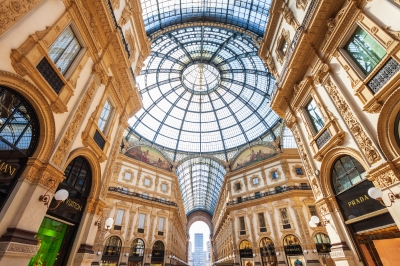
The world’s most prestigious shopping area encompassing Via Montenapoleone and surrounding streets. Home to flagship stores of famous Italian and international designers.
Connectivity:
By Metro:
- Montenapoleone: Direct access to the western side of the district – Line M3
- San Babila: 200 meters (3-minute walk) to the southern side – Line M1
- Palestro: 400 meters (5-minute walk) to the eastern side – Line M1
- Turati: 600 meters (7-minute walk) to the northern side – Line M3
- Duomo: 700 meters (9-minute walk) – Lines M1, M3
By Bus:
- Line 61: Stop at “Via Senato”
- Line 94: Stop at “Via Manzoni”
- Line 54: Stop at “Corso Vittorio Emanuele II”
- Line 73: Stop at “San Babila”
By Tram:
- Line 1: Stop at “Via Manzoni – Montenapoleone M3”
- Line 1: Stop at “Piazza Cavour”
- Line 9: Stop at “Via Manzoni”
- Line 4: Stop at “Via Senato”
Chiesa di San Maurizio al Monastero Maggiore

Often called “Milan’s Sistine Chapel” for its breathtaking interior completely covered in Renaissance frescoes by Bernardino Luini and other Leonardo da Vinci’s followers.
Connectivity:
By Metro:
- Cairoli: 550 meters (7-minute walk) – Line M1
- Cadorna FN: 750 meters (10-minute walk) – Lines M1, M2
- Sant’Ambrogio: 800 meters (10-minute walk) – Line M2
- Cordusio: 1 kilometer (12-minute walk) – Line M1
- Lanza: 1.1 kilometers (14-minute walk) – Line M2
By Bus:
- Line 50: Stop at “Via Meravigli” (near Cairoli)
- Line 58: Stop at “Corso Magenta – Via Nirone”
- Line 94: Stop at “Cadorna FN M1 M2”
By Tram:
- Line 16: Stop at “Corso Magenta – Via Nirone” (closest stop)
- Line 19: Stop at “Via Carducci – Corso Magenta”
- Lines 1, 2, 4: Stop at “Via Meravigli” (near Cairoli)
Leonardo da Vinci National Museum of Science and Technology

Housed in a 16th-century monastery, this museum displays models created from Leonardo’s drawings, along with extensive collections related to transport, energy, and space exploration.
Connectivity:
By Metro:
- Sant’Ambrogio: 300 meters (5-minute walk) – Line M2
- Conciliazione: 600 meters (10-minute walk) – Line M1
By Bus:
- Line 50: Stop at “San Vittore” or nearby stops.
- Line 58: Stops right at the entrance of the museum.
- Line 94: Also stops near the museum
By Tram:
- Via Olona: Served by tram line 14.
- Viale San Michele del Carso: Served by tram line 10.
Florence

Uffizi Gallery

One of the world’s greatest art museums housing masterpieces of the Renaissance. The collection includes works by Botticelli (Birth of Venus, Primavera), Leonardo da Vinci, Michelangelo, Raphael, and Titian. The building itself, designed by Vasari, was originally offices (uffizi) for the Medici administration. Reserve tickets in advance to avoid the notoriously long lines.
Connectivity:
By Bus:
- Lines 23, 23A, 23B: These buses stop at Galleria Degli Uffizi, just a 3-minute walk from the gallery.
- Lines 6A, 6B: These buses stop nearby, requiring a short walk.
- Lines C1, C2, C3, C4: These central routes are useful for visitors coming from various parts of the city center
By Tram:
- Stations: San Marco – Università, Valfonda – Stazione S.M.N.
- Lines: 3
Duomo Complex (Cathedral of Santa Maria del Fiore)

Florence’s iconic cathedral features Brunelleschi’s revolutionary dome – the largest brick dome ever constructed. Climb the 463 steps to the top for panoramic city views.
The complex includes Giotto’s Campanile (bell tower), the ancient Baptistery with its magnificent bronze doors by Ghiberti, and the Duomo Museum housing Michelangelo’s Pietà and Donatello’s Mary Magdalene.
Connectivity:
By Bus:
- Lines C1, C2, C3: These buses stop at Proconsolo, Santa Maria Maggiore, and other nearby stops.
- Lines 6A, 6B, 11, 14, 23, 23N: These buses also stop near the Duomo, with stops like Vecchietti and Pucci Duomo
Nearest Bus Stops
- Proconsolo: A 4-minute walk from the Duomo.
- Santa Maria Maggiore: A 4-minute walk away.
- Vecchietti: A 4-minute walk from the Duomo.
- Pucci Duomo: A 5-minute walk away
By Tram:
- Stations: Santa Maria Novella:
- Lines: T1, T2.
Galleria dell’Accademia

Home to Michelangelo’s David, the 17-foot marble masterpiece that embodies Renaissance ideals of human form and beauty. The museum also houses Michelangelo’s unfinished Prisoners sculptures, seemingly struggling to break free from their marble blocks, along with important paintings by Botticelli and other Florentine masters.
Connectivity:
By Bus:
- Lines 14 and 23: These buses stop at Museo Di San Marco, which is a short walk from the gallery.
- Lines 6 and 31: Also stop nearby, providing easy access to the gallery.
Nearest Bus Stops
- Museo Di San Marco: A short walk from the gallery.
- Piazza San Marco: A 1-minute walk away.
By Tram:
- Stations: Santa Maria Novella
- Lines: T1, T2.
Ponte Vecchio

Florence’s oldest and most famous bridge spans the Arno River at its narrowest point. Built in 1345, it’s known for the shops built along its edges – originally occupied by butchers but now filled with jewelers and souvenir sellers.
The Vasari Corridor runs above the shops, a private elevated passageway built for the Medici to travel between the Pitti Palace and Uffizi.
Connectivity:
By Bus:
- Lines C1, C2, C3: These buses stop at nearby locations like Proconsolo and Santa Maria Maggiore.
- Lines 6 and 31: Also stop nearby, providing easy access to the bridge.
Nearest Bus Stops
- Proconsolo: A 4-minute walk from Ponte Vecchio.
- Santa Maria Maggiore: A 4-minute walk away.
- Vecchietti: A 4-minute walk from the bridge.
By Tram:
- Stations: Santa Maria Novella
- Lines: T1, T2.
Palazzo Pitti and Boboli Gardens

This massive Renaissance palace houses several museums including the Palatine Gallery (with works by Raphael, Titian, and Rubens) and the Royal Apartments. Behind the palace, the Boboli Gardens exemplify formal Italian garden design with fountains, grottos, and classical statues spread across 111 acres of terraced landscape.
Connectivity:
By Bus:
- Lines C3, C4, D, 11, 12, and 13: These buses stop at Borgo S. Jacopo, which is a short walk from the palace and gardens
Nearest Bus Stops:
- Borgo S. Jacopo: A short walk from Palazzo Pitti and Boboli Gardens.
- Piazza de’ Pitti: Close to the palace entrance.
By Tram:
- Stations: Unità.
Piazza della Signoria and Palazzo Vecchio

Florence’s main square serves as an open-air sculpture gallery featuring Cellini’s Perseus, Giambologna’s Rape of the Sabine Women, and a copy of Michelangelo’s David. The medieval Palazzo Vecchio (Old Palace) was the seat of Florentine government and is still used as the city hall. Inside, visitors can explore elaborately decorated chambers including the Hall of the Five Hundred.
Connectivity:
By Bus:
- Lines C1, C2, C3: These buses stop at nearby locations like Proconsolo and Santa Maria Maggiore.
- Lines 6 and 31: Also stop nearby, providing easy access to the square.
Nearest Bus Stops:
- Proconsolo: A 4-minute walk from Piazza della Signoria.
- Santa Maria Maggiore: A 4-minute walk away.
- Vecchietti: A 4-minute walk from the square.
By Tram:
- Stations: Santa Maria Novella.
- Lines: T1, T2.
San Lorenzo and Medici Chapels
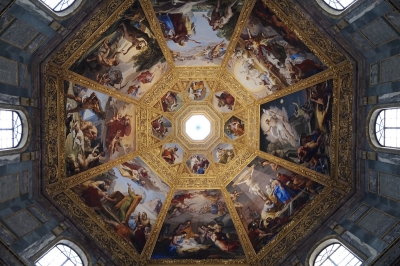
The Medici family church contains Michelangelo’s architectural masterpiece – the Laurentian Library with its unusual staircase. The attached Medici Chapels include the New Sacristy with Michelangelo’s sculptural groups representing Day, Night, Dawn, and Dusk on the Medici tombs, and the Chapel of the Princes, an opulent mausoleum decorated with precious stones.
Connectivity:
By Bus:
- Lines C1, C2, C3: These buses stop at nearby locations like Proconsolo and Santa Maria Maggiore.
- Lines 6 and 31: Also stop nearby, providing easy access to the basilica.
Nearest Bus Stops
- Proconsolo: A 4-minute walk from San Lorenzo.
- Santa Maria Maggiore: A 4-minute walk away.
- Vecchietti: A 4-minute walk from the basilica.
By Tram:
- Stations: Santa Maria Novella.
- Lines: T1, T2.
Santa Croce Basilica

The largest Franciscan church in the world serves as Florence’s Westminster Abbey, containing tombs and monuments to famous Italians including Michelangelo, Galileo, Machiavelli, and Rossini.
The Pazzi Chapel in the church complex represents one of Brunelleschi’s most perfect architectural works, while the interior features important frescoes by Giotto.
Connectivity:
By Bus:
- Lines C1, C2, C3: These buses stop nearby, providing easy access to the basilica
Nearest Bus Stops
- Piazza Santa Croce: A short walk from the basilica.
- Via de’ Benci: A 4-minute walk away.
By Tram:
- Stations: Santa Maria Novella.
- Lines: T1, T2.
Piazzale Michelangelo

This panoramic terrace offers the most famous view of Florence, with the Duomo, Palazzo Vecchio, and Arno River spread before you. Built in the 19th century as part of urban renewal, it features bronze copies of Michelangelo’s sculptures. Particularly magical at sunset, when the city’s Renaissance skyline is bathed in golden light.
Connectivity:
By Bus:
- Bus 12 or 13: These buses depart from the city center and take about 10 minutes to reach the square
Nearest Bus Stops
- Piazzale Michelangelo: Directly at the square.
- Piazza Poggi: A short walk from the base of the hill leading to the square.
By Tram:
- Stations: Santa Maria Novella.
- Lines: T1, T2.
Mercato Centrale and San Lorenzo Market

Experience Florence’s culinary traditions at the two-story Mercato Centrale. The ground floor houses traditional vendors selling fresh produce, meats, and local specialties, while the upper floor offers prepared foods. Outside, the San Lorenzo Market stalls sell leather goods, clothing, and souvenirs in the tradition of Florence’s mercantile history.
Connectivity:
By Bus:
- Lines C1, C2, C3: These buses stop nearby, providing easy access to the markets.
Nearest Bus Stops
- Piazza del Mercato Centrale: Directly at the market.
- Via dell’Ariento: A short walk from the market.
By Tram:
- Stations: Santa Maria Novella.
- Lines: T1, T2.
Amalfi Coast

Positano

This postcard-perfect town is the jewel of the Amalfi Coast with its pastel-colored houses dramatically cascading down the cliffside to the azure Mediterranean Sea. The town centers around the Chiesa di Santa Maria Assunta with its majolica-tiled dome and 13th-century Byzantine Madonna icon.
Wander through narrow alleys lined with boutiques selling handmade sandals, linen clothing, and ceramics. Spiaggia Grande beach offers sunbathing opportunities, while restaurants like La Sponda and Le Sirenuse provide incredible dining experiences with coastal views.
For the adventurous, take the path to the quieter Fornillo Beach or hike to Nocelle village above the town.
Ravello

Perched 365 meters above the sea, Ravello offers a peaceful retreat from the coastal crowds. Villa Rufolo, dating back to the 13th century, features magnificent gardens that inspired Wagner’s opera Parsifal and hosts summer concerts during the Ravello Festival.
Nearby Villa Cimbrone boasts the “Terrace of Infinity” with its marble busts and arguably the most breathtaking panoramic view on the entire coast. The town’s elegant main square, Piazza Vescovado, is home to the impressive 11th-century Duomo (Cathedral) and charming cafés.
Oscar Niemeyer’s striking modern auditorium adds an architectural contrast to the medieval surroundings.
Amalfi Town

The coast’s namesake and historical maritime republic, Amalfi impresses with its magnificent Duomo di Sant’Andrea featuring striking black and white striped Byzantine-Arab-Norman architecture and a grand staircase leading to its entrance.
Inside, don’t miss the Cloister of Paradise (Chiostro del Paradiso) with its interlaced Moorish arches. The town’s Paper Museum (Museo della Carta) showcases Amalfi’s traditional handmade paper industry that dates back to the 13th century.
The lively main square, Piazza del Duomo, and the bustling marina offer numerous dining options and boat excursions. The ancient Arsenal of the Maritime Republic (Arsenale della Repubblica) gives insight into Amalfi’s powerful naval past.
Path of the Gods (Sentiero degli Dei)

This legendary 7.8 km hiking trail follows ancient mule paths between Agerola (specifically the hamlet of Bomerano) and Nocelle (above Positano). Walking among terraced vineyards and lemon groves, you’ll experience some of the Mediterranean’s most spectacular scenery with views stretching from the island of Capri to the Sorrento Peninsula.
The moderately challenging trail takes about 3-4 hours one-way and reveals hidden hamlets, wild flora, and dramatic limestone formations. Local legends claim the path was used by the gods to reach the sea and save Ulysses from the sirens.
Most hikers start in Bomerano and descend to Nocelle, following the path downhill.
Capri

Though technically not on the Amalfi Coast, this island paradise is easily accessible by boat from various coastal towns. The famous Blue Grotto (Grotta Azzurra) sea cave illuminates with an otherworldly blue light due to sunlight passing through an underwater cavity.
Take the chairlift to Monte Solaro, the island’s highest point, for panoramic views. The Gardens of Augustus offer spectacular vistas of the iconic Faraglioni rock formations. The elegant Piazzetta (officially Piazza Umberto I) serves as a sophisticated outdoor living room for people-watching.
Visit Villa Jovis, Emperor Tiberius’s spectacular cliff-top residence, or take the scenic boat trip around the island to see hidden coves and dramatic rock formations.
Furore

Known as “the town that doesn’t exist,” Furore isn’t a traditional town center but rather houses scattered along the hillside. Its magnificent fjord (Fiordo di Furore) is a narrow inlet with vertical limestone cliffs, crossed by a high arched bridge that hosts diving competitions.
The small pebble beach at the bottom of the fjord, though often shaded in the afternoon, is a unique swimming spot. The entire village is an “alfresco museum” with colorful murals painted on houses. Visit the tiny Anna Magnani Museum, dedicated to the acclaimed actress who filmed “L’Amore” here with Roberto Rossellini.
Furore is also known for its microclimate that produces excellent wines, particularly from the native Fenile and Ripoli grapes.
Atrani

Just a short walk east of Amalfi yet worlds apart in atmosphere, Atrani is the smallest municipality in Italy (by area) and retains an authentic fishing village charm. Its picturesque central square, Piazza Umberto I, is surrounded by charming restaurants and leads directly to a small but lovely beach.
The 10th-century Church of San Salvatore de’ Birecto was once the coronation site for the doges of the Maritime Republic of Amalfi. Climb the steps from the main square to the Church of Santa Maria Maddalena with its distinctive majolica dome overlooking the town.
Atrani’s medieval urban layout, with narrow alleys and covered passages, has remained largely unchanged over the centuries, making it a photographer’s paradise.
Valle delle Ferriere

This spectacular natural reserve near Amalfi provides a refreshing contrast to the coastal landscapes. The valley features lush vegetation, waterfalls, streams, and ruins of medieval ironworks (hence the name “Valley of the Ironworks”).
The microclimate supports rare plants including the Woodwardia radicans, a prehistoric fern dating back 65 million years. The upper part of the reserve (Riserva Integrale) protects the most pristine ecosystems.
The trail can be accessed from either Amalfi or Pontone (part of Scala), with the latter route offering more spectacular views. Several waterfalls along the path provide cooling spots during summer hikes, while the ruins of paper mills highlight the area’s industrial heritage.
Tuscany

Tuscany is one of Italy’s most beloved regions, known for its picturesque landscapes, rich history, remarkable art, and exceptional cuisine. Here’s a comprehensive guide to the places you absolutely shouldn’t miss when visiting this stunning Italian region:
Siena

This well-preserved medieval city centers around the distinctive shell-shaped Piazza del Campo, site of the famous Palio horse race. The striking black-and-white marble cathedral (Duomo) contains masterpieces by Donatello, Michelangelo, and Bernini.
Siena’s medieval tower houses, winding streets, and rich artistic heritage make it a fascinating contrast to Florence.
San Gimignano

Often called the “Medieval Manhattan,” this small hilltop town is famous for its remarkably well-preserved medieval towers. Of the original 72 towers, 14 remain, creating a distinctive skyline visible from miles away.
The town offers excellent examples of Romanesque and Gothic architecture, along with notable frescoes in its Collegiate Church.
Pisa

While most famous for its Leaning Tower, Pisa’s Campo dei Miracoli (Field of Miracles) is a UNESCO World Heritage site featuring four masterpieces of medieval architecture: the cathedral, baptistery, campanile (the leaning tower), and the Camposanto cemetery.
The city itself has much more to offer beyond this iconic complex, including a historic university and lovely riverfront areas.
Val d’Orcia

This stunning agricultural region epitomizes the quintessential Tuscan landscape that has inspired artists for centuries. Rolling hills dotted with cypress trees, golden fields, and isolated farmhouses create a timeless panorama.
Visit charming towns like Pienza (the “ideal Renaissance city”), Montalcino (home of Brunello wine), and Montepulciano (known for its Vino Nobile).
Chianti Region
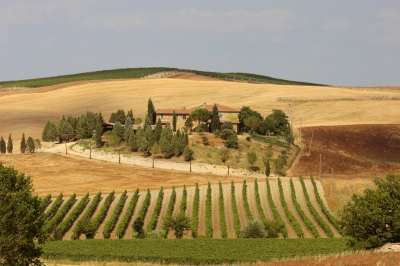
The famous wine region between Florence and Siena offers a perfect blend of natural beauty, historic towns, and culinary excellence.
Visit ancient castles now serving as wineries, such as Castello di Brolio, and explore charming towns like Greve, Radda, and Castellina in Chianti. Wine tastings and farm-to-table dining experiences are essential activities here.
Lucca

Unique for its fully intact Renaissance walls that now serve as a pedestrian promenade circling the city, Lucca offers a less touristy experience.
The elliptical Piazza dell’Anfiteatro, built on the remains of a Roman amphitheater, retains its original shape. Climb the unusual Guinigi Tower with oak trees growing from its top for a distinctive view.
Cortona
Made famous by Frances Mayes’ book “Under the Tuscan Sun,” this hillside town offers spectacular views over Lake Trasimeno and the surrounding countryside. Its Etruscan origins are evident in the city walls and archaeological museum.
The town’s steep, narrow streets reveal Renaissance palaces, medieval churches, and inviting piazzas.
Thermal Baths
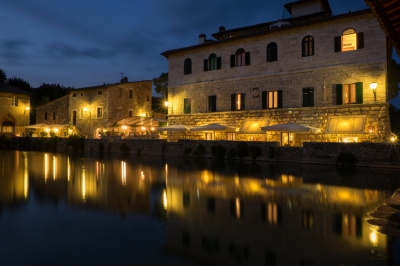
Tuscany has been known for its thermal waters since Etruscan and Roman times. Towns like Montecatini Terme, Bagno Vignoni (with its unique main square consisting of a pool of thermal water), and Saturnia (with its natural cascading hot springs) offer relaxing experiences in healing mineral waters.
Elba Island
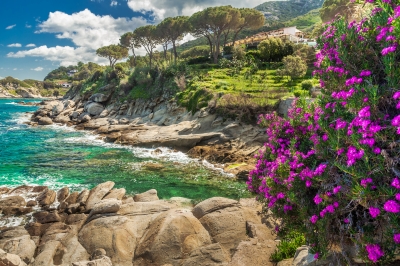
The largest island in the Tuscan Archipelago offers crystal-clear waters, beautiful beaches, and hiking trails. Historically significant as Napoleon’s place of exile, Elba combines natural beauty with fascinating history.
Naples and Pompeii

Naples and Pompeii offer some of Italy’s most fascinating historical experiences, combining ancient Roman history with vibrant Neapolitan culture. Let me guide you through the essential places to visit in both locations, explaining why each site matters and how they connect to the broader historical and cultural landscape of the region.
Naples (Napoli)
The Historic Center (Centro Storico)

Naples’ historic center is a UNESCO World Heritage site and represents one of Europe’s largest and most intact historical districts. Walking through these narrow streets is like traveling through different layers of history, from Greek foundations to medieval structures to baroque splendor.
The “Spaccanapoli” (literally “Naples splitter”) is a straight, narrow street that bisects the old historic center and dates back to the Greek-Roman city planning. As you walk this ancient thoroughfare, you’re following in footsteps laid down more than 2,500 years ago.
Connectivity:
By Bus:
Nearest Bus Stops
- Piazza Garibaldi: A major hub for buses and trams.
- Via Toledo: Buses stop nearby, though not directly in the Historic Center.
By Tram:
- Stations: Piazza Garibaldi.
- Lines: Tram Line 1
By Metro:
- Lines: Line 1, Line 2.
Nearest Metro Stops
- Università: A short walk from the Historic Center.
- Dante: Also near the Historic Center.
- Toledo: Close to the Spanish Quarter.
National Archaeological Museum (Museo Archeologico Nazionale)
This museum houses one of the world’s finest collections of Greco-Roman artifacts, with most treasures coming directly from Pompeii and Herculaneum. The “Secret Cabinet” (Gabinetto Segreto) contains ancient erotic art that was considered so scandalous it was kept locked away from the general public for centuries.
The Alexander Mosaic, recovered from Pompeii’s House of the Faun, depicts Alexander the Great in battle and represents one of the most detailed and skilled mosaics from antiquity.
Connectivity:
By Bus:
- Lines:R4, 201, 203, C55, 147, 168, 178, 184, and 139.
Nearest Bus Stops
- Piazza Museo Nazionale: Directly in front of the museum.
- Cavour – Metropolitana: A short walk away.
By Metro:
- Lines: Line 1, Line 2.
Nearest Metro Stops
- Museo: A minute’s walk from the museum.
- Cavour: An 8-minute walk from the museum.
Underground Naples (Napoli Sotterranea)

Beneath the bustling streets lies another city—a network of Greek-Roman aqueducts, catacombs, and tunnels later used as air raid shelters during World War II. This underground labyrinth tells the story of Naples from below, revealing how the city has continuously built upon itself over millennia.
The limestone extracted to build the underground chambers was used to construct the buildings above, creating a symbiotic relationship between Naples above and below ground.
Connectivity
By Bus:
- Lines: R4, 201, 203, C55, 147, 168, 178, and 184.
Nearest Bus Stops
- Piazza Museo Nazionale: A short walk from the historic center.
- Via dei Tribunali: Buses stop nearby.
By Metro:
- Lines: Line 1, Line 2.
Nearest Metro Stops
- Dante: A short walk from Piazza San Gaetano.
- Cavour: Also within walking distance.
Cappella Sansevero
This small chapel contains Giuseppe Sanmartino’s “Veiled Christ,” a marble sculpture so delicately rendered that the thin veil covering Christ appears translucent. The chapel also houses anatomical models with mysterious origins that have puzzled scientists for centuries.
The entire chapel represents the intersection of baroque art, esoteric symbolism, and scientific curiosity that characterized the Enlightenment period.
Connectivity
By Bus:
- Bus 151: Via Nuova Marina stop.
- Bus 154: Marchese Campodisola stop.
- Bus R2: Corso Umberto stop.
- Filobus 202: Corso Umberto stop.
By Metro:
- Lines: Line 1, Line 2.
Nearest Metro Stops
- Università (Line 1): About a 5-minute walk from Cappella Sansevero.
- Dante (Line 1): Also about a 5-minute walk away.
- Cavour (Line 2): An 8-minute walk from the chapel.
Castel dell’Ovo

Naples’ oldest castle sits on a small island and offers panoramic views of the Bay of Naples. According to legend, the Roman poet Virgil magically placed an egg in the foundations, and should this egg ever break, both the castle and Naples would face catastrophe. This folklore exemplifies the blend of classical history and magical thinking that permeates Neapolitan culture.
Connectivity
By Bus:
Bus 151: Take bus 151 to Piazza Vittoria and walk about 10-15 minutes along Via Partenope to reach the castle
Castel Nuovo (Maschio Angioino)

This medieval castle features a remarkable Renaissance triumphal arch celebrating Alfonso V of Aragon’s entry into Naples in 1443. The castle has witnessed key moments in the history of Naples as it passed between French, Spanish, and Italian control, reflecting the city’s complex political history.
Connectivity
By Bus:
- Lines: 101, 151, 201, R2, and N1.
By Metro:
-
-
-
- Lines: Line 1.
-
-
Nearest Metro Stops
-
-
-
- Municipio-Porto.
-
-
Naples Cathedral (Duomo)

The cathedral houses the Chapel of San Gennaro, containing the blood of Naples’ patron saint. Twice yearly, crowds gather to witness what many believe is the miraculous liquefaction of the dried blood. This phenomenon bridges ancient religious tradition with contemporary faith practices that remain central to Neapolitan identity.
Connectivity
By Bus:
-
-
-
- Lines: 101, 151, 201, R2, and N1.
-
-
By Metro:
-
-
-
- Lines: Line 1, Line 2.
-
-
Nearest Metro Stops
-
-
-
- Duomo (Line 1): About a 300-meter walk from the cathedral.
-
-
-
-
-
- Piazza Cavour (Line 2): About a 400-meter walk away.
-
-
Via San Gregorio Armeno
Famous for its artisan workshops creating nativity scenes (presepi), this street showcases Naples’ exceptional craftsmanship tradition. Beyond traditional figures, artisans incorporate contemporary celebrities and politicians, demonstrating how living tradition evolves while maintaining historical techniques.
Connectivity
By Bus:
-
-
-
- Lines: 101, 151, 201, R2, and N1.
-
-
By Metro:
-
-
-
- Lines: Line 1,.
-
-
Nearest Metro Stops
-
-
-
- Duomo (Line 1): About a 300-meter walk from the cathedral.
-
-
Pompeii
The Forum
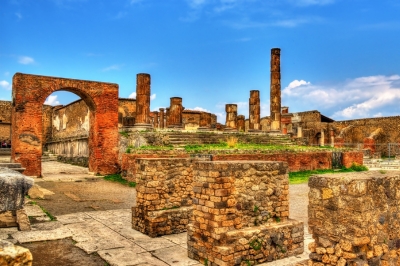
The political, religious, and commercial heart of ancient Pompeii provides insight into Roman civic life before the eruption of 79 CE. Standing in this open square with Vesuvius visible in the background creates a powerful connection between the ancient disaster and the present archaeological treasure.
Connectivity
By Train:
-
-
-
- Trains: Circumvesuviana Train, Campania Express.
-
-
-
-
-
- Stations: Pompei Scavi – Villa dei Misteri.
-
-
House of the Vettii
One of the best-preserved and most lavishly decorated private homes in Pompeii, it belonged to two wealthy merchants. The elaborate frescoes depict mythological scenes and daily life, offering a glimpse into both the aesthetic tastes and social aspirations of the wealthy Roman merchant class.
Connectivity
By Train:
-
-
-
- Trains: Circumvesuviana Train, Campania Express.
-
-
-
-
-
- Stations: Pompei Scavi – Villa dei Misteri.
-
-
Villa of the Mysteries

Located just outside the city walls, this villa contains a remarkable fresco cycle that may depict initiation into the cult of Dionysus. These mysterious images have challenged historians’ understanding of ancient religious practices and continue to generate new interpretations about private religious experiences in the Roman world.
The Amphitheater
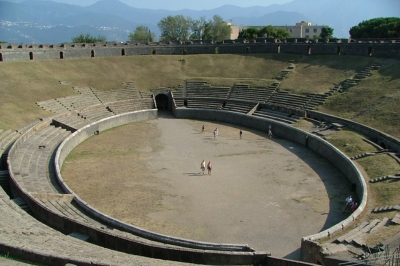
The oldest surviving Roman amphitheater, built around 70 BCE, could hold up to 20,000 spectators.
Interestingly, we know from historical records that a riot broke out here during a gladiatorial contest between locals and visitors from nearby Nuceria in 59 CE, resulting in a ten-year ban on games—just twenty years before the eruption permanently silenced the arena.
The Brothel (Lupanare)
This small building with explicit frescoes and stone beds offers insight into the regulated sex trade in Roman society. The erotic artwork served both as advertisement and as instruction for patrons who might not speak the local language, demonstrating the practical aspects of communication in a multiethnic Roman society.
Garden of the Fugitives

Plaster casts of victims caught in their final moments provide a haunting reminder of the human tragedy behind the archaeological site. These casts were created by pouring plaster into voids left in the hardened ash where bodies had decomposed, preserving the exact positions of people in their final moments. They represent one of the most direct emotional connections we can have with the ancient past.
House of the Tragic Poet
Despite its modest size, this house contains some of Pompeii’s finest mosaics, including the famous “Cave Canem” (Beware of the Dog) mosaic at the entrance. This juxtaposition of high artistic achievement in a middle-class home challenges our assumptions about access to art in Roman society.
The Bakeries and Thermopolia
These commercial establishments with intact ovens and food counters give us a vivid picture of how ordinary Romans purchased their daily food. The carbonized loaves of bread found in some bakeries are almost identical to traditional bread still baked in the region today, demonstrating culinary continuity across two millennia.
Beyond Pompeii
Herculaneum
Often overlooked in favor of Pompeii, Herculaneum was preserved by mudflows rather than ash, resulting in exceptional preservation of wooden elements, fabrics, and second stories of buildings.
The site is less crowded and offers a more intimate experience of Roman daily life. The Villa of the Papyri, partially excavated here, contained a library of over 1,800 papyrus scrolls that modern technology is only now beginning to decipher.
Mount Vesuvius
Climbing the volcano that caused the destruction of Pompeii offers both thrilling views and a profound connection to the geological forces that shaped this region’s history. The volcano remains active, adding a sense of living danger to the historical experience. The last major eruption occurred in 1944, damaging nearby towns and an American air base during World War II.
Lago di Como
Lake Como (Lago di Como) in northern Italy is one of the most beautiful lakes in the world, surrounded by lush mountains and dotted with charming towns. Here’s a more detailed look at the top 10 places to visit:
Bellagio

The “Pearl of Lake Como” sits at the junction of the lake’s three branches. Wander through its perfectly preserved medieval center with narrow, steep streets lined with boutiques, cafés, and artisan shops. Don’t miss Villa Melzi Gardens with its azaleas, rhododendrons, and Egyptian sculptures. The lakefront promenade offers spectacular views across the water to the surrounding mountains.
Villa del Balbianello

Located on a wooded peninsula near Lenno, this 18th-century villa is famous for its elaborate terraced gardens and extraordinary views. Featured in movies like “Star Wars: Episode II” and “Casino Royale,” the villa houses a fascinating collection of artifacts from the expeditions of its last owner, explorer Guido Monzino. The meticulously maintained gardens with perfectly pruned trees are simply breathtaking.
Varenna
This authentic fishing village offers a more relaxed atmosphere than some of the lake’s more famous destinations. Its colorful houses cascade down to the waterfront, and the “Lovers’ Walk” (Passeggiata degli Innamorati) is a romantic lakeside promenade. Visit Villa Monastero with its botanical garden housing plants from around the world, and the nearby 11th-century Castello di Vezio with falconry displays and stunning panoramas.
Como City

The lake’s principal city combines Renaissance architecture with modern amenities. The magnificent Duomo (Cathedral) features Gothic and Renaissance elements with impressive tapestries and paintings. Take the funicular railway to Brunate for breathtaking views, explore the Tempio Voltiano museum dedicated to Alessandro Volta (inventor of the electric battery), and stroll through the elegant Piazza Cavour overlooking the harbor.
Villa Carlotta

This 17th-century villa in Tremezzo houses masterpieces by Canova and Hayez and is surrounded by 70,000 square meters of botanical gardens. Visit in spring when the 150+ varieties of azaleas and rhododendrons are in bloom. The villa’s terraced gardens offer spectacular views across to Bellagio, and the interior features ornate period furniture, frescoed ceilings, and marble sculptures.
Menaggio

This elegant resort town features a pretty waterfront promenade lined with oleanders and palm trees. The heart of town is the lively Piazza Garibaldi with outdoor cafés perfect for people-watching. Menaggio is also a gateway for hikers heading into the surrounding mountains, with trails offering spectacular lake views. Visit the remains of the medieval castle or play a round at the challenging 18-hole Menaggio & Cadenabbia Golf Club.
Lecco
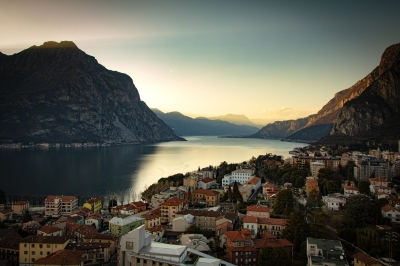
Situated at the end of the southeastern branch of Lake Como, Lecco is surrounded by mountains including the distinctive Resegone peak. The city has strong literary connections as the setting for Alessandro Manzoni’s famous novel “The Betrothed.” The beautiful waterfront features 19th-century buildings, and the Campanile di San Nicolò bell tower offers stunning panoramic views. The nearby Piani d’Erna cable car takes visitors to mountain hiking trails with spectacular vistas.
Nesso

This picturesque village between Como and Bellagio is built on a steep slope where a gorge divides the town in two. The highlight is the Orrido di Nesso, a spectacular gorge and waterfall that plunges directly into the lake, best viewed from the ancient Roman bridge. The small harbor (Nesso Porto) offers a glimpse of traditional lake life away from the tourist centers.
Isola Comacina

Lake Como’s only island has a rich history dating back to Roman times. Once home to numerous churches and fortifications, it was largely destroyed in 1169. Today, visitors can explore archaeological remains, enjoy a meal at the island’s famous restaurant Locanda dell’Isola Comacina (which has served the same menu since 1947), or attend the annual San Giovanni Festival with its spectacular fireworks display.
Cernobbio
This elegant town is home to some of Lake Como’s most impressive villas. Villa d’Este, now a luxury hotel, features magnificent Renaissance architecture and gardens with a floating swimming pool on the lake. Villa Erba, once home to director Luchino Visconti, hosts major events and exhibitions. The town’s center features charming squares and the beautiful lakeside promenade offers mountain views. Nearby, the challenging hiking trail Strada Regia connects Cernobbio to other lake villages.
The best time to visit Lake Como is from April to October, with May, June, and September offering pleasant weather with fewer crowds. Consider using the efficient ferry system to hop between these locations—seeing the towns from the water adds another dimension to your Lake Como experience.
Best Time to Visit Italy for Tourism
Italy is wonderful year-round, but certain seasons offer distinct advantages depending on your priorities. Here’s a breakdown to help you plan the perfect Italian vacation:
Spring (April to June)
-
-
-
- Ideal for: Countryside exploration, comfortable sightseeing, photography
-
-
-
-
-
- Advantages: Moderate temperatures (60-75°F/15-24°C), blooming landscapes, fewer crowds than summer
-
-
-
-
-
- Highlights: Easter celebrations, wildflowers in Tuscany, perfect hiking weather in Cinque Terre
-
-
-
-
-
- Considerations: April can still bring rain showers, especially in northern regions
-
-
Early Summer (Late May to June)
-
-
-
- Advantages: Warm weather before extreme heat, longer daylight hours, beach destinations beginning to open
-
-
-
-
-
- Highlights: Local festivals and sagre (food festivals), Festa della Repubblica (June 2)
-
-
-
-
-
- Considerations: Popular sites getting busier, prices beginning to rise
-
-
Late Summer/Early Fall (September to Mid-October)
-
-
-
- Ideal for: Beach vacations with fewer crowds, wine enthusiasts, balanced sightseeing
-
-
-
-
-
- Advantages: Warm temperatures, grape harvest season, sea still warm enough for swimming
-
-
-
-
-
- Highlights: Venice Film Festival (early September), truffle hunting season begins, wine harvests
-
-
-
-
-
- Considerations: Still relatively busy in major cities, occasional rain in late September
-
-
Fall (Mid-October to November)
-
-
-
- Ideal for: Food lovers, museum-focused trips, budget travelers
-
-
-
-
-
- Advantages: Significantly fewer tourists, fall colors in northern regions, lower prices
-
-
-
-
-
- Highlights: White truffle season, olive harvests, fall cuisine (porcini, chestnuts)
-
-
-
-
-
- Considerations: Cooler temperatures, some coastal businesses closing for season
-
-
Winter (December to March)
-
-
-
- Ideal for: Christmas markets, skiing in the Alps/Dolomites, budget city exploration
-
-
-
-
-
- Advantages: Lowest tourist numbers (except Christmas/New Year), winter sales in January
-
-
-
-
-
- Highlights: Christmas markets in northern cities, Carnevale (February), skiing
-
-
-
-
-
- Considerations: Shorter days, cooler temperatures, some rural attractions closed
-
-
Overall Best Times
-
-
-
- For fewer crowds and good weather: May and September-October
-
-
-
-
-
- For beaches and sunshine: June and September
-
-
-
-
-
- For budget travel: November and January-March (excluding holidays)
-
-
-
-
-
- For winter sports: December-March
-
-
Remember that Italy’s climate varies significantly from north to south, with the Alpine north being cooler and the Mediterranean south staying milder year-round.
Activities to Do in Italy
-
-
-
- Cooking Classes: Many cooking schools offer half-day or full-day experiences where you learn to make pasta from scratch, perfect pizza dough, or create authentic gelato. Classes typically include market shopping with the chef, hands-on preparation, and enjoying your creations with wine pairings. Cities like Bologna, Florence, and Rome have excellent options, with prices ranging from €60-150 per person.
-
-
-
-
-
- Wine Tasting: Regions like Tuscany (Chianti), Piedmont (Barolo), and Veneto (Prosecco) offer structured tastings at family-run vineyards. During September-October harvest season, some wineries let visitors participate in grape picking and traditional crushing. Many vineyards offer tours that explain their specific production methods, aging processes, and terroir.
-
-
-
-
-
- Football Matches: Serie A matches run from August to May in cities like Milan, Rome, Turin, and Naples. The atmosphere is electric with passionate fans, chants, and choreographed displays. Tickets range from €20-150 depending on the match importance. Derby matches between city rivals (like Inter vs. AC Milan) are particularly intense cultural experiences.
-
-
-
-
-
- Truffle Hunting: Join expert hunters and their trained dogs in regions like Piedmont, Umbria, and Tuscany. These 2-3 hour morning excursions take you through forests where you search for white truffles (October-December) or black truffles (winter/summer depending on variety). Most tours include a meal featuring your findings.
-
-
-
-
-
- Hiking: The Dolomites offer dramatic Alpine trails for all levels, with well-marked paths and mountain refuges for overnight stays. Cinque Terre has the famous Blue Path connecting five villages along the coast. Sicily’s volcanic landscapes and Sardinia’s wild coastlines provide unique hiking opportunities with Mediterranean views.
-
-
-
-
-
- Vespa Rental: Daily rentals cost around €50-80, with many companies offering suggested route maps. The Tuscan countryside, Puglia’s coastal roads, and Sicily’s mountain passes are particularly scenic. Some companies organize guided Vespa tours for those less confident about navigating Italian roads independently.
-
-
-
-
-
- Cultural Festivals: Key events include Venice Carnival (February), Siena’s Palio horse race (July/August), Florence’s Scoppio del Carro Easter celebration, Verona’s summer opera festival, and countless local food festivals (sagre) celebrating seasonal specialties like truffles, chestnuts, or wild boar.
-
-
-
-
-
- Boating: Along the Amalfi Coast, companies offer day trips to sea caves and hidden coves. Lake Como features elegant wooden boats for rent. Sailing lessons are available in Sardinia and Sicily, with week-long courses for beginners. In Venice, you can take rowing lessons in traditional gondolas or smaller boats.
-
-
-
-
-
- Thermal Baths: Natural hot springs in Tuscany (Saturnia), Ischia island, and Bormio in the Alps offer therapeutic mineral-rich waters. Many historic bath complexes date back to Roman times but now feature modern spa facilities with treatments ranging from €30-150.
-
-
-
-
-
- Skiing: The Dolomites region (particularly around Cortina d’Ampezzo) features over 1,200km of slopes suitable for all levels, with reliable snow from December to April. The Aosta Valley near the French border offers magnificent views of Mont Blanc. Daily ski passes range from €40-60 with equipment rental available at most resorts.
-
-
-
-
-
- Grape Stomping: During September-October harvest, vineyards in regions like Tuscany and Piedmont organize traditional grape stomping events where visitors remove shoes and crush grapes by foot in wooden vats. These often include harvest meals in the vineyards, folk music, and celebrations of the new vintage.
-
-
Transportation in Italy
Transportation in Italy offers a comprehensive and efficient network that makes exploring the country relatively straightforward. The national railway system, operated by Trenitalia, forms the backbone of Italian transportation with high-speed trains (Frecciarossa) connecting major cities in just a few hours, while regional trains service smaller towns at more affordable rates. Within cities, public transportation typically includes buses, trams, and in larger urban centers like Rome, Milan, and Naples, metro systems that provide convenient access to main attractions.
For areas not serviced by trains, regional bus companies fill the gaps, though schedules may be limited in rural locations, especially on weekends. Many travelers choose to rent cars for exploring countryside regions like Tuscany or Sicily, but should be aware of ZTL zones (limited traffic zones) in historic centers and the toll fees on autostrade (highways).
In coastal areas and islands, ferries and hydrofoils offer essential connections, with services being particularly important for reaching Sicily, Sardinia, and the smaller islands dotting Italy’s coastline. Venice, of course, presents a unique transportation experience with its network of vaporetti (water buses) and traditional gondolas navigating the famous canals.
Taxis are readily available in urban areas, though they should be taken from official stands or booked through apps, while ride-sharing services operate with some limitations depending on the city. Cycling has gained popularity, particularly in northern Italian cities, with bike-sharing programs available for tourists seeking a more active way to explore urban centers. For longer distances, domestic flights connect major cities and provide quick access to islands, with carriers like ITA Airways, Ryanair, and EasyJet offering regular service between key destinations.
For more details visit https://www.rome.net/
Major Airports and Train Stations in Italy
International Airports
Italy hosts several international airports serving as vital gateways for tourists and business travelers. The most significant ones include:
Northern Italy
-
-
-
- Leonardo da Vinci International Airport (FCO) – Rome’s primary airport and Italy’s busiest, handling approximately 43 million passengers annually. Located in Fiumicino, about 32 km southwest of Rome’s city center.
-
-
-
-
-
- Milan Malpensa Airport (MXP) – Northern Italy’s largest international hub, situated about 49 km northwest of Milan. It serves as a key gateway for intercontinental flights.
-
-
-
-
-
- Venice Marco Polo Airport (VCE) – The principal airport serving Venice, located on the mainland near Mestre, approximately 13 km from Venice.
-
-
-
-
-
- Milan Linate Airport (LIN) – Milan’s city airport, primarily handling domestic and short-haul European flights, located just 7 km east of the city center.
-
-
-
-
-
- Bologna Guglielmo Marconi Airport (BLQ) – Serving the Emilia-Romagna region and providing access to Bologna and Florence, located 6 km northwest of Bologna city center.
-
-
Central Italy
-
-
-
- Pisa International Airport (PSA) – Officially Galileo Galilei Airport, serving as the main gateway to Tuscany, located just 1.5 km from Pisa city center.
-
-
-
-
-
- Florence Airport (FLR) – Officially Amerigo Vespucci Airport, providing convenient access to Florence, situated about 4 km northwest of the city center.
-
-
Southern Italy and Islands
-
-
-
- Naples International Airport (NAP) – The principal airport for southern Italy, located 5.6 km northeast of Naples city center.
-
-
-
-
-
- Catania-Fontanarossa Airport (CTA) – Sicily’s busiest airport, serving the eastern part of the island, located 4.3 km southwest of Catania.
-
-
-
-
-
- Palermo Airport (PMO) – Officially Falcone Borsellino Airport, serving western Sicily, located 35 km west of Palermo.
-
-
-
-
-
- Cagliari Elmas Airport (CAG) – Sardinia’s primary airport, located 7 km northwest of Cagliari.
-
-
Major Train Stations
Italy’s extensive rail network is anchored by several significant train stations in major cities:
Rome
-
-
-
- Roma Termini – Italy’s largest train station and a major transportation hub, handling approximately 150 million passengers annually. It serves high-speed, regional, and international trains.
-
-
-
-
-
- Roma Tiburtina – Rome’s second-largest station, increasingly handling high-speed trains to reduce congestion at Termini.
-
-
Milan
-
-
-
- Milano Centrale – One of Europe’s largest railway stations, featuring monumental architecture and serving as northern Italy’s main rail hub.
-
-
-
-
-
- Milano Porta Garibaldi – A significant secondary station serving high-speed trains and suburban lines.
-
-
Florence
-
-
-
- Firenze Santa Maria Novella – Located in the heart of Florence, serving high-speed trains and regional services.
-
-
Venice
-
-
-
- Venezia Santa Lucia – Located on the Grand Canal in Venice proper, serving trains from mainland Italy.
-
-
-
-
-
- Venezia Mestre – On the mainland, serving as a transfer point for trains to Venice and other destinations.
-
-
Naples
-
-
-
- Napoli Centrale – The main station in Naples, serving high-speed trains from Rome and northern Italy, as well as regional services.
-
-
Bologna
-
-
-
- Bologna Centrale – A crucial junction in Italy’s rail network, where lines from the north, south, east, and west converge.
-
-
Turin
-
-
-
- Torino Porta Nuova – Turin’s main station, serving high-speed trains to Milan and beyond.
-
-
Verona
-
-
-
- Verona Porta Nuova – A key station in northeastern Italy, serving trains to Venice, Milan, and international destinations.
-
-
Rome
Overview of Transport Tickets
Rome offers various ticket options to suit different travel needs. The BIT one-way ticket (€1.50) provides 100 minutes of unlimited transfers between metro, buses, trams, and urban trains, with the only restriction being re-entry into the metro. For those planning longer stays, Rome offers several time-based passes: MetroBus 24 hours (€7), MetroBus 48 hours (€12.50), MetroBus 72 hours (€18), and a Weekly Pass (€24) for unlimited transportation over 7 days. The OMNIA Rome & Vatican Card includes free public transport and priority access to major attractions. Tickets can be purchased at metro stations, convenience stores, and newsstands throughout the city.
Metro System
Rome’s metro system consists of three main lines that connect most of the city’s top attractions:
Line A (Orange) runs northwest to southeast from Battistini to Anagnina with 27 stations. Key stops include Cipro-Musei Vaticani (closest to Vatican Museums and Sistine Chapel), Ottaviano-San Pietro (near St. Peter’s Square and Basilica), Spagna (for Piazza di Spagna and Villa Borghese), Barberini-Fontana di Trevi (five minutes from Trevi Fountain and closest to Piazza Navona and the Pantheon), and Termini (main railway station and connection to Fiumicino Airport via Leonardo Express).
Line B (Blue) runs northeast to south from Laurentina to either Rebibbia or Jonio, covering 22 stations plus a four-station extension. Important stops include Termini (transfer point between lines), Colosseo (near the Colosseum and Roman Forum), and Piramide (connection to the FR1 regional train from Fiumicino).
Line B1 splits at Bologna station, with branches continuing to Rebibbia and Jonio.
Line C (Green) connects San Giovanni (Line A) to Monte Compatri-Pantano, running from the center to the east of Rome.
The metro operates daily from 5:30 am to 11:30 pm, with extended service until 1:30 am on Fridays and Saturdays.
Bus Network
Rome has an extensive bus system with 338 daytime routes, 22 night bus lines, and 8,260 stops throughout the city. The bus network includes:
Urban lines (U): The majority of buses, operating from 5:00-6:30 am until midnight with varying frequency.
Night buses (N): Running between midnight and 5:00-6:00 am, these less frequent but reliable services keep the city connected overnight.
Express lines (X): Serving Rome’s outskirts for longer journeys.
Exact lines (E): Running on fixed timetables between the city center and surrounding neighborhoods.
For tourists, Rome offers specialized sightseeing buses:
City Sightseeing provides hop-on, hop-off service with English commentary and tickets valid for 24, 48, or 72 hours. Buses operate daily from 9 am to 5:45 pm.
Big Bus offers similar hop-on, hop-off tours past major attractions like the Pantheon, Roman Forum, St. Peter’s Basilica, Spanish Steps, and Colosseum. Services run from 9 am to 7 pm daily with departures approximately every 28 minutes from Via Giovanni Giolitti, 32, near Termini station. Ticket options include 24, 48, and 72-hour passes plus a 1 hour 35 minute single journey without stops.
Big Bus also offers a special Night Tour departing at 8:20 pm and 8:30 pm daily (€18, family offers available), showcasing Rome’s illuminated monuments. This night tour is included with the 72-hour ticket.
Tram Lines
Rome’s tram network consists of six lines:
-
-
-
- Line 2: Piazza Mancini – Piazzale Flaminio
-
-
-
-
-
- Line 3: Piazza Thorwaldsen – Trastevere
-
-
-
-
-
- Line 5: Giovanni Amendola – Piazza dei Gerani
-
-
-
-
-
- Line 8: Torre Argentina – Trastevere
-
-
-
-
-
- Line 14: Giovanni Amendola – Palmiro Togliatti
-
-
-
-
-
- Line 19: Piazza Risorgimento – Piazza dei Gerani
-
-
For tourists, Line 8 is particularly useful as it connects Trastevere with Largo di Torre Argentina. All trams operate daily from 5:30 am until midnight.
Urban Railway Lines
The Ferrovie Urbane (Urban Railways) includes three lines:
-
-
-
- Rome – Lido
-
-
-
-
-
- Rome – Viterbo
-
-
-
-
-
- Rome – Giardinetti
-
-
The Rome-Lido line is most relevant for tourists as it stops at Ostia Antica. Most suburban trains operate from approximately 5:30 am to 10:30 pm, with the Rome-Lido line running later, offering final departures at 11:30 pm.
Taxis
Taxis in Rome have a reputation for being expensive, and visitors should be cautious about potential overcharging. The most economical way to use taxis is to find official taxi stands throughout the city. Alternatively, taxis can be reserved by phone through companies such as:
-
-
-
- Radio Taxi: 06-3570
-
-
-
-
-
- Pronto Taxi: 06-6645
-
-
-
-
-
- Other companies: 06-5551, 06-4994, 06-4157
-
-
Using official taxi services is recommended to ensure fair pricing and reliable service.
Venice
Venice presents a unique transportation landscape unlike any other city in the world. What makes Venice truly exceptional is its compact size and watery foundation. The city center is remarkably small, allowing visitors to traverse its entirety on foot in approximately 30 minutes. This pedestrian-friendly character is one of Venice’s most charming aspects, eliminating the need for conventional transportation when staying in the central districts.
The defining feature of Venice is its intricate network of canals, which serve as the city’s primary transportation arteries. While conventional wheeled vehicles operate in limited areas, the heart of Venice relies on waterborne transportation. This creates a distinctive environment where everything from public transit to emergency services operates on water. Police boats, ambulances, and taxis all navigate the Venetian canals, creating a transportation ecosystem that has evolved over centuries to accommodate the city’s unique geography.
For more details visit https://www.introducingvenice.com/
Vaporetto: Venice’s Water Bus System
The vaporetto, Italian for “little steamer,” represents the backbone of Venice’s public transportation system. These water buses effectively replace traditional land-based public transit within the city center. Beyond their practical function, vaporettos offer an experience that transcends mere transportation – they provide a romantic and quintessentially Venetian way to travel, allowing passengers to absorb the city’s architectural splendor from its historic waterways.
Key Vaporetto Lines for Tourists
The vaporetto network includes several lines that are particularly valuable for visitors:
Line 1: Perhaps the most essential route for tourists, Line 1 travels along the Grand Canal at a leisurely pace, connecting the central bus terminal at Piazzale Roma with Venezia Lido. This scenic route makes stops at major landmarks throughout the journey, including Piazza San Marco, Ca’Rezzonico, and the iconic Rialto Bridge. The slower pace of this line makes it ideal for sightseeing and photography.
Line 3: This line provides direct service between Piazzale Roma and the island of Murano, famous for its glass-making tradition. It offers a convenient connection for visitors interested in witnessing the island’s artisanal glass production.
Line 7: Operating between Piazza San Marco and Murano, this line offers another option for reaching the glass-making island, this time departing from Venice’s most famous square.
Line 10: For travelers seeking the quickest connection between Piazza San Marco and Lido, Line 10 provides the most efficient service. This is particularly useful for beachgoers heading to Lido’s sandy shores.
Line 18: This line facilitates travel between Lido and Murano, connecting two of Venice’s most visited islands without requiring a transfer in the main city.
Vaporetto Schedule
The vaporetto system operates on an extended schedule to accommodate both early risers and night owls. Most lines begin service at 4:30 AM and continue until 12:30 AM (midnight), providing nearly 20 hours of daily operation. This extensive schedule ensures that visitors can rely on public transportation throughout their daily activities in Venice.
Water Taxis in Venice
While convenient, water taxis represent a premium transportation option in Venice. The city’s public transportation system, including these private water taxis, comes with a relatively high price tag compared to other European cities. However, water taxis can be a practical choice for larger groups, as they can accommodate up to 10 passengers, effectively distributing the cost. These sleek vessels offer a more personalized and direct transportation experience, navigating the smaller canals that larger vaporettos cannot access.
The Gondola Experience
The gondola stands as perhaps the most recognizable symbol of Venetian transportation. These distinctive narrow, elongated boats are propelled by a single gondolier using a long oar. While gondolas once served as the primary mode of transportation throughout Venice, with the canals teeming with thousands during the 17th century, they have evolved into a primarily tourist-oriented attraction today.
Modern gondolas primarily serve as a romantic and traditional way to experience Venice’s waterways. They offer a more intimate and historical perspective on the city, allowing passengers to glide through narrow canals inaccessible to larger vessels. Though no longer a practical daily transportation option for locals, gondolas remain an essential part of Venice’s cultural identity and tourism appeal.
Traghetti: Canal Crossing Ferries
“Traghetti” – Italian for “ferries” – represent a practical solution for crossing the Grand Canal. These larger gondola-like vessels serve both locals and tourists, providing a convenient alternative to walking to the nearest bridge.
Traghetti Schedule
It’s important to note that traghetti primarily serve the local Venetian workforce, operating on schedules designed around typical working hours. As such, they run only during certain times of the day, and some routes do not operate on weekends. Visitors planning to use traghetti should verify the operating hours for their desired crossing point, as service can be limited or unavailable during off-peak hours.
Alilaguna: Airport-to-City Water Transportation
The Alilaguna company operates specialized water ferry services connecting Marco Polo Airport with Venice’s city center. This service provides a direct water link between the airport and various points throughout Venice and its surrounding islands.
Alilaguna Routes and Lines
Alilaguna maintains six distinct lines, each serving different routes and purposes:
Blue Line: Provides direct service between Marco Polo Airport and the Venice Cruise Terminal, catering to cruise passengers transitioning between their ships and flights.
Orange Line: Connects Marco Polo Airport directly to Piazza San Marco, offering visitors a scenic introduction to the city upon arrival.
Red Line: Seasonal service (April through October) linking Marco Polo Airport with Lido, particularly useful during the warmer months when Lido’s beaches attract visitors.
Yellow Line: Operates between Fondamenta Nuove and several destinations including Murano, Punta Sabbioni, and Treporti. This route is seasonal, operating only during the peak summer months of July and August.
Green Line: This specialized route serves as a guided tour connecting Murano, Burano, and Torcello. The journey takes approximately 4 hours and includes narration about the various sights along the way. This service costs €18 (US$19.46) per person and is particularly popular among tourists seeking a comprehensive introduction to Venice’s island communities.
Alilaguna Schedule and Frequency
Alilaguna’s water buses operate on an extended schedule to accommodate air travelers:
-
-
-
- The first boat departs Marco Polo Airport at 6:15 AM
-
-
-
-
-
- The last departure from the airport is at 12:40 AM (midnight)
-
-
-
-
-
- From Piazza San Marco, service begins at 3:50 AM and continues until 10:50 PM
-
-
This extensive schedule ensures that travelers can reliably use Alilaguna services regardless of their flight times, providing nearly 24-hour connectivity between the airport and the city.
Land-Based Transportation
Buses in Venice
Conventional land buses do not operate on the main island of Venice due to its unique geography and absence of roads. However, buses serve critical functions in connecting Venice to the mainland and operate in specific areas:
-
-
-
- At Venice Marco Polo Airport, ACTV buses provide the most economical transportation option to reach Piazzale Roma, the city center’s transportation hub.
-
-
-
-
-
- Buses operate regularly on the mainland, particularly in Mestre, and on certain islands like Lido where conventional roads exist.
-
-
-
-
-
- Within Venice itself, Piazzale Roma marks the terminus for land-based transportation. Only the Santa Croce neighborhood permits limited bus and automobile traffic, serving as the transition point between land and water transportation systems.
-
-
Venice Tourist Cards
Rolling Venice Card for Young Travelers
The Rolling Venice Card offers an excellent value proposition for young tourists aged 6-29 visiting Venice. Priced at €6 (US$6.36), this card’s primary benefit is the substantial discount of €18 (US$19.10) on the 72-hour travel card. This reduction applies to several transportation options, including the standard 72-hour unlimited public transport ticket (reduced to €27/US$28.65), the 72-hour transport ticket with one journey to Marco Polo Airport (reduced to €34/US$36.08), and the 72-hour transport ticket with a return journey to Marco Polo Airport included (reduced to €40/US$42.45). Beyond transportation savings, cardholders also receive discounts for numerous attractions featured in the Venice Card, with notable inclusions being the Doges Palace, Correr Museum, and Ca’ Rezzonico Palace.
Venezia Unica City Pass: Customizable Tourism Solution
The Venezia Unica City Pass represents a more comprehensive and customizable approach to exploring Venice. This personalized pass allows visitors to create a bespoke package based on their specific needs and interests. The pass consolidates various services into a single card, including public transportation, museum and monument access, cultural events, WiFi connectivity, parking facilities, and special offers at Venetian restaurants.
The pass grants access to numerous prominent landmarks including the Doge’s Palace, Museo Correr, Ca’ Rezzonico, Ca’ Pesaro, 18 churches included in the Chorus Pass, Teatro La Fenice, Fondazione Querini Stampalia, Jewish Museum of Venice, Venice Casino, and the Naval Historical Museum. Additionally, cardholders benefit from discounts on exhibitions, cultural events, and excursions; special pricing on audio guides and museum catalogs; reduced rates at major Venice car parks; discounted access to public toilets; special offers at select galleries, stores, and libraries; price reductions at participating cafés, bars, and clubs; priority access to certain museums; and a complimentary city map.
The standard Venezia Unica City Pass covering the city’s principal attractions is priced at €52.90 (US$56.14) for adults. For transportation options, the pass offers various durations: a 1-day transport card at €25 (US$26.53), a 2-day card at €35 (US$37.14), a 3-day card at €45 (US$47.75), and a 7-day option at €65 (US$68.98). This tiered pricing structure allows visitors to select the transportation coverage that best aligns with their planned duration of stay in Venice.
Milan
Milan’s public transportation system comprises an extensive and well-integrated network of various transit options. The city’s transportation infrastructure is designed to provide comprehensive coverage, enabling residents and visitors to navigate efficiently throughout the metropolitan area. This integrated system connects all corners of this vibrant Italian city, making it accessible and convenient for travelers to explore Milan’s diverse neighborhoods, cultural attractions, and commercial districts.
For more details visit https://www.milanpublictransportation.com/
Milan Pass Light:
The Milan Pass Light represents a strategic choice for visitors seeking to maximize their exploration of the city. This versatile pass is specifically designed with travelers’ needs in mind, offering flexible duration options to accommodate different itineraries.
Pass Options and Pricing
The Milan Pass Light is available in three distinct timeframes to suit various travel schedules:
-
-
-
- 24-hour Pass: Priced at €13.99, this option is ideal for visitors on brief stays who wish to experience Milan’s essential attractions within a single day.
-
-
-
-
-
- 48-hour Pass: Available for €20.99, this pass caters to weekend travelers seeking to discover Milan’s multifaceted identity as a capital of style, art, and design.
-
-
-
-
-
- 3-day Pass: At €22.99, this extended option provides ample time to explore Milan’s diverse offerings, from historical monuments and museums to upscale boutiques and international dining establishments.
-
-
Key Benefits and Features
The Milan Pass Light includes several significant advantages:
-
-
-
- Unlimited Public Transportation: The pass serves as a comprehensive travel ticket, granting unrestricted access to all public transportation modes within the city, including metro lines, buses, and trams.
-
-
-
-
-
- Welcome Drink: Pass holders receive a complimentary glass of Prosecco at After Pier in the vibrant Navigli district, offering an authentic taste of Milanese nightlife.
-
-
-
-
-
- Audio Guide: The pass includes over 20 hours of audio content, providing an immersive experience with detailed information about Milan’s history, points of interest, and fascinating anecdotes.
-
-
-
-
-
- Navigation Tools: Holders benefit from both interactive digital maps and traditional paper maps, ensuring confident navigation throughout the city center.
-
-
-
-
-
- Discount Program: The pass offers a 10% discount on numerous experiences, including major attractions and guided tours throughout Milan.
-
-
Milan Metro System:
The Milan Metro holds the distinction of being Italy’s most extensive metro system, representing a significant engineering achievement completed in the 1960s. Despite its relatively modest size compared to other European capitals, it serves as a critical transportation artery for the city.
System Overview
The Milan Metro network comprises:
-
-
-
- Four operational lines
-
-
-
-
-
- 111 stations
-
-
-
-
-
- Total length of 58.7 miles (94.5 km), making it the longest metro system in Italy
-
-
Line Details
The system features four numbered and color-coded lines, each serving distinct areas of the city:
-
-
-
- Line M1 (Red): Particularly valuable for business travelers visiting Fiera Milano, this line also services key tourist destinations including the Duomo cathedral and San Babila.
-
-
-
-
-
- Line M2 (Green): This line provides convenient access to Milano Centrale, the city’s main railway station, along with other significant locations.
-
-
-
-
-
- Line M3 (Yellow): Highly advantageous for tourists, this line stops at essential landmarks including the Duomo, Via Montenapoleone (Milan’s premier shopping district), and Milano Centrale.
-
-
-
-
-
- Line M5 (Purple): Integrated with regional train services, this line offers connections to Garibaldi station and Stadio Giuseppe Meazza (San Siro stadium).
-
-
Ticket Information
Metro tickets and travel cards can be purchased at various locations throughout the city, including:
-
-
-
- Metro stations
-
-
-
-
-
- Kiosks
-
-
-
-
-
- Off-licenses (authorized retailers)
-
-
Operating Hours
The Milan Metro operates daily from 6:00 AM until 12:30 AM (midnight), providing extensive service throughout the day and evening.
Milan’s Historic Tram Network
Trams have been an integral component of Milan’s transportation landscape since their introduction in 1876. The system is renowned for its efficiency and represents one of the most convenient and expeditious methods of navigating the city.
Network Scope
The Milan tram network features:
-
-
-
- 18 distinct lines
-
-
-
-
-
- Routes numbered from 1 to 33
-
-
-
-
-
- Extended operational hours compared to the metro and bus systems
-
-
Operating Schedule
Trams in Milan provide service from approximately 4:30 AM – 5:00 AM until 2:00 AM – 2:30 AM, offering expanded transportation options during early morning and late evening hours.
Milan’s Comprehensive Bus System
Given the relatively limited coverage of the metro network, Milan’s urban buses constitute an essential component of the city’s transportation infrastructure. The system includes both standard buses and trolley buses (electric buses operating via overhead wires).
Network Extent
The bus system comprises:
-
-
-
- Over 80 local bus lines
-
-
-
-
-
- Several trolley bus routes
-
-
-
-
-
- Comprehensive coverage throughout the metropolitan area
-
-
Night Bus Service
Since 2015, Milan has implemented a dedicated night bus service operating seven days a week:
-
-
-
- Fifteen designated routes
-
-
-
-
-
- Service hours from midnight until 6:00 AM
-
-
-
-
-
- Departures every 30 minutes
-
-
-
-
-
- Routes primarily servicing popular nightlife districts
-
-
-
-
-
- Standard ticketing system applies to night services
-
-
-
-
-
- Tickets available from parking meters throughout the city at €1.50
-
-
Airport Connection
For travelers arriving at Linate Airport, the bus system offers economical transportation to the city center:
-
-
-
- Buses 73 and X73 connect the airport to San Babila metro station
-
-
-
-
-
- Standard one-way ticket price of €1.50
-
-
-
-
-
- Represents the most cost-effective transfer option from Linate Airport
-
-
Operating Hours
The regular bus service operates from approximately 5:30 AM – 6:00 AM until 12:30 AM (midnight) – 1:45 AM, providing extensive daily coverage.
Integrated Ticketing System
Milan’s public transportation system utilizes a unified ticketing structure, allowing passengers to use the same tickets and travel cards across all modes of transportation, including:
-
-
-
- Metro
-
-
-
-
-
- Trams
-
-
-
-
-
- Buses (including night services)
-
-
-
-
-
- Airport connections
-
-
The standard one-way ticket costs €1.50 and can be purchased from various locations throughout the city, including metro stations, authorized retailers, and parking meters.
Florence
Florence, renowned for its rich Renaissance heritage, presents a unique transportation profile that caters admirably to visitors and residents alike. The city’s compact historic center makes it primarily conducive to pedestrian exploration, with most major attractions located within comfortable walking distance of one another.
For travelers accommodated within the city center or its immediate vicinity, public transportation often becomes a supplementary rather than primary means of navigation. Nevertheless, Florence maintains a robust transportation network that extends beyond the walkable core, facilitating broader exploration of this culturally significant urban center.
For more details visit https://www.introducingflorence.com/
Bus Network: The Primary Public Transit Option
Florence’s bus system constitutes the most extensive element of its public transportation infrastructure, with approximately 100 distinct routes traversing the metropolitan area. This comprehensive network provides connectivity between the historic center and the city’s outer districts, as well as links to suburban areas and nearby communities.
Key Bus Routes for Visitors
Several bus lines offer particular utility for tourists:
Lines C1, C2, C3, and C4 operate as electric services, providing environmentally conscious transportation options particularly suited to Florence’s historic environment. These lines serve important corridors through the city and represent sustainable mobility solutions.
Lines 12 and 13 merit special attention for visitors interested in exploring Florence’s southern panoramic points. These routes ascend the hill south of the Arno River, providing access to the renowned Piazzale Michelangelo and the Church of San Miniato al Monte, two vantage points offering spectacular views of the Florence cityscape.
Nottetempo: Evening Transportation Service
Unlike major European cities with comprehensive night bus networks, Florence implements a more tailored evening transportation solution called “Nottetempo.” This specialized service operates from 10:00 PM until 2:00 AM, covering various city neighborhoods. The service operates on a reservation basis, requiring passengers to call ahead to confirm schedules and service areas.
To access this evening service, travelers can contact the reservation line at 055-5650555. This number provides information on operational schedules, coverage areas, and boarding locations, allowing visitors to plan their evening transportation needs efficiently.
Ticket Acquisition and Validation
Bus tickets in Florence can be purchased through multiple channels:
-
-
-
- At designated bus stops equipped with ticket vending machines
-
-
-
-
-
- Directly on board the buses
-
-
-
-
-
- At authorized retailers throughout the city
-
-
Buses feature two validation points, positioned at the front and rear of the vehicle. Passengers must validate their tickets upon boarding to activate the time-limited validity period.
For visitors planning multiple journeys, purchasing multiple tickets simultaneously or investing in an ATAF (Florence Transport) pass represents a more efficient approach than individual ticket purchases for each journey.
Operating Hours
The standard bus service in Florence operates from 6:00 AM until 10:00 PM daily, providing comprehensive coverage during primary daytime hours and early evening.
Tram System: Peripheral Connectivity
While Florence’s tram system plays a less central role in tourist mobility due to its routes not traversing the historic center, it nonetheless provides valuable connectivity for areas beyond the medieval core. The system currently encompasses three active lines serving outlying districts and connecting to peripheral transportation hubs.
Operational Advantages
The tram system offers distinct advantages over road-based transportation, particularly in terms of reliability and traffic avoidance. Operating on dedicated tracks, trams bypass the congestion that occasionally affects bus routes and taxi services, providing more consistent journey times during peak periods.
Ticket Purchase Options
Tram tickets can be acquired at all tram stations throughout the network, with automated vending machines providing convenient purchasing options for passengers.
Schedule and Frequency
The tram system maintains extended operating hours, with service from 5:30 AM until midnight daily. This schedule accommodates both early morning commuters and evening travelers, providing transportation options across a broad temporal spectrum.
Service frequency varies according to time of day:
-
-
-
- During peak daytime hours, trams operate at 3-4 minute intervals, providing frequent connectivity
-
-
-
-
-
- During evening hours, service intervals extend to approximately 12 minutes between departures
-
-
Florence Transport Tickets and Travel Cards
Florence’s public transportation system implements a unified ticketing structure that applies across all modes of public transit, including buses and trams. This integrated approach provides flexibility for passengers utilizing multiple transportation types during their journeys.
Single Journey Ticket
The standard single journey ticket provides 90 minutes of unlimited travel from the moment of validation. This time-limited validity allows passengers to complete multi-segment journeys or round trips within the specified timeframe using any combination of buses and trams.
Passengers must validate their tickets using the yellow validation machines located on buses and at tram stations. The current cost for a single journey ticket is €1.50 (US$1.62).
Agile 10 Card
For passengers planning multiple journeys, the Agile 10 Card offers enhanced value and convenience. This magnetic card contains 10 individual 90-minute journeys, providing the equivalent of 10 single tickets at a reduced aggregate cost.
A noteworthy feature of this card is its transferability—multiple passengers can utilize the same card for simultaneous travel, with each passenger consuming one journey from the card’s allocation. The current cost for the Agile 10 Card is €14 (US$15.16), representing a modest discount compared to purchasing 10 individual tickets.
Amalfi coast
The Amalfi Coast, a UNESCO World Heritage site stretching along 50 kilometers of Italy’s southern Sorrentine Peninsula, presents unique transportation challenges and opportunities. The region’s dramatic topography of steep cliffs, narrow coastal roads, and picturesque villages nestled between mountains and sea creates a distinctive transportation landscape that requires careful navigation. This guide provides comprehensive information on the various transportation options available to visitors exploring this stunning coastal region.
SITA Bus Network
The SITA bus network serves as the primary public transportation system connecting the towns and villages of the Amalfi Coast. This extensive network provides a cost-effective method for traversing the region, though it requires understanding of its operations for optimal utilization.
Route Structure
The main SITA bus route runs along the coastal highway (SS163 Amalfitana), connecting major destinations including Sorrento, Positano, Praiano, Amalfi, and Salerno. Additional branch routes extend to inland villages and towns such as Ravello, Scala, and Agerola.
Key routes include:
-
-
-
- Sorrento-Positano-Amalfi
-
-
-
-
-
- Amalfi-Salerno
-
-
-
-
-
- Amalfi-Ravello
-
-
-
-
-
- Amalfi-Agerola
-
-
Schedule
During peak tourist season (April through October), buses typically operate from approximately 6:00 AM until 9:00 PM.
Ticket Information
SITA bus tickets must be purchased in advance at authorized vendors, including:
-
-
-
- Tabacchi shops (tobacco shops marked with a “T” sign)
-
-
-
-
-
- Newspaper stands
-
-
-
-
-
- Selected hotels and tourism offices
-
-
-
-
-
- Bus stations in major towns
-
-
Tickets cannot be purchased directly from drivers. Upon boarding, passengers must validate their tickets using the stamping machines located on the buses.
Ferry Services
Maritime transportation offers a scenic alternative to road travel, allowing visitors to appreciate the Amalfi Coast’s dramatic scenery from the water while avoiding road congestion.
Routes and Operators
Several ferry companies operate along the coast, including:
-
-
-
- Travelmar
-
-
-
-
-
- Alilauro
-
-
-
-
-
- NLG (Navigazione Libera del Golfo)
-
-
Primary routes connect:
-
-
-
- Sorrento-Positano-Amalfi-Salerno
-
-
-
-
-
- Amalfi-Positano-Capri
-
-
-
-
-
- Salerno-Positano-Amalfi
-
-
Seasonal Considerations
Ferry service is highly seasonal, with comprehensive service generally available from April through October. During winter months, service is limited or suspended entirely, depending on weather conditions and demand.
Travel Time and Frequency
Ferry travel times compare favorably to bus transportation:
-
-
-
- Sorrento to Positano: Approximately 40 minutes
-
-
-
-
-
- Positano to Amalfi: Approximately 30 minutes
-
-
-
-
-
- Amalfi to Salerno: Approximately 35 minutes
-
-
During peak season, ferries operate multiple times daily on major routes, with reduced frequency on secondary connections.
Ticketing and Boarding
Ferry tickets can be purchased:
-
-
-
- At harbor ticket offices
-
-
-
-
-
- Through hotel concierge services
-
-
-
-
-
- Via online booking platforms
-
-
Reservations are recommended during peak season. Passengers should arrive at least 20 minutes before scheduled departure time.
Private Transportation Options
For travelers seeking greater flexibility and comfort, several private transportation options are available.
Taxi Services
Licensed taxis operate throughout the Amalfi Coast, providing on-demand transportation. Taxis can be:
-
-
-
- Hailed at designated taxi stands in major towns
-
-
-
-
-
- Ordered via telephone
-
-
-
-
-
- Arranged through hotel concierge services
-
-
Taxi fares are regulated but relatively expensive compared to public transportation. Negotiating the fare before departure is advisable.
Rental cars are available from major agencies at Naples International Airport, Salerno, and Sorrento.
Transportation Hubs and Connections
Several key transportation hubs serve as gateways to the Amalfi Coast.
Naples
Naples International Airport (Capodichino) serves as the primary air gateway to the region. From Naples, travelers can:
-
-
-
- Take direct buses to Sorrento (Curreri Viaggi)
-
-
-
-
-
- Use the Circumvesuviana train to Sorrento
-
-
-
-
-
- Arrange private transfers to Amalfi Coast destinations
-
-
-
-
-
- Take ferries from Naples port to Sorrento or directly to Positano and Amalfi (seasonal)
-
-
Salerno
Salerno serves as the eastern gateway to the Amalfi Coast with:
-
-
-
- Direct train connections to major Italian cities
-
-
-
-
-
- SITA bus connections to coastal towns
-
-
-
-
-
- Ferry services to Positano, Amalfi, and Minori
-
-
-
-
-
- Proximity to major highways for car travelers
-
-
Sorrento
Sorrento functions as the western gateway with:
-
-
-
- Terminus of the Circumvesuviana train from Naples
-
-
-
-
-
- Major SITA bus hub for coastal destinations
-
-
-
-
-
- Port with ferry connections to Capri, Naples, and Amalfi Coast towns
-
-
-
-
-
- Concentration of car rental agencies and private transfer services
-
-
Tuscany
Tuscany’s Railway Network
The northern portion of Tuscany benefits from particularly robust rail connectivity, with Florence serving as the central hub of the regional network. From Florence, direct rail connections extend to numerous significant destinations within Tuscany, including:
-
-
-
- Pisa
-
-
-
-
-
- Pistoia
-
-
-
-
-
- Lucca
-
-
-
-
-
- Livorno
-
-
-
-
-
- Arezzo
-
-
This network configuration facilitates convenient day trips from Florence to these destinations, making rail an excellent option for exploring the region’s diverse attractions.
For more details visit
Bus Transportation in Tuscany
While trains effectively connect Tuscany’s larger cities and towns, the bus network provides essential complementary service, reaching numerous smaller communities and areas not served by rail. Several major companies operate bus services throughout the region, each covering specific territories.
BUS ITALIA – SITA
This major operator provides extensive service throughout central Tuscany, connecting Florence with significant areas including:
-
-
-
- Chianti wine region
-
-
-
-
-
- Siena
-
-
-
-
-
- Arezzo
-
-
-
-
-
- Valdarno
-
-
-
-
-
- Casentino
-
-
-
-
-
- Mugello
-
-
For travelers based in Florence, the SITA service to Siena warrants particular attention as it represents the most efficient public transportation option between these two important Tuscan cities. SITA’s Florence office, which provides both information and ticket services, is conveniently located near Santa Maria Novella train station at Via Santa Caterina da Siena, 15. Information is available via telephone at 800 373760.
CAP
Formerly operating under the name LAZZI, CAP focuses on connections between Florence and the northwestern areas of Tuscany, including:
-
-
-
- Prato
-
-
-
-
-
- Pistoia
-
-
-
-
-
- Mugello region
-
-
Travelers can access information and tickets at CAP’s Florence office, situated at Largo Fratelli Alinari, 10. Additional information is available by calling 055 214637.
TIEMME
TIEMME serves as the principal bus operator for southern Tuscany, providing essential connections throughout this less densely populated region. The company’s service area encompasses:
-
-
-
- Arezzo and surroundings
-
-
-
-
-
- Certaldo
-
-
-
-
-
- San Gimignano
-
-
-
-
-
- Siena and its province
-
-
-
-
-
- Grosseto
-
-
-
-
-
- Piombino
-
-
-
-
-
- Coastal areas of the Maremma region
-
-
Information regarding TIEMME’s services can be obtained by calling 800 922984 from landlines or 199 168182 from mobile phones.
Naples and Pompeii
For more details visit https://naplespublictransport.it/
Metro System
Naples boasts a comprehensive metro system that serves as the backbone of the city’s public transportation network. The system features two primary lines that connect key areas of the city and surrounding suburbs:
Line 1 (Yellow Line)
-
-
-
- Route: Extends from Piscinola to Garibaldi
-
-
-
-
-
- Key Areas Served: Piazza Garibaldi (adjacent to Napoli Centrale train station), the port area, the Duomo, Via Toledo, and the National Archaeological Museum
-
-
-
-
-
- Significance: Considered the main metro line for tourists and locals alike, providing convenient access to major attractions and commercial districts
-
-
Line 2 (Blue Line)
-
-
-
- Route: Runs from Pozzuoli to Gianturco
-
-
-
-
-
- Key Areas Served: Connects Pozzuoli’s historic sites with Naples’ city center
-
-
-
-
-
- Significance: Provides vital connections between suburban areas and the metropolitan core
-
-
Operating Hours
The Naples Metro operates daily from 6:00 AM to 11:00 PM, offering frequent service throughout the day at affordable fares.
Funicular Railway System
Naples features three funicular railways that ascend the city’s steep hills, providing both practical transportation and scenic views:
Centrale Funicular
-
-
-
- Operating Hours:
-
- Monday-Tuesday: 7:00 AM to 10:30 PM
-
- Wednesday, Thursday, Sunday: 7:00 AM to 12:30 AM
-
- Friday and Saturday: 7:00 AM to 2:00 AM
-
- Operating Hours:
-
-
-
-
-
- Primary Destination: Vomero district
-
-
Montesanto Funicular
-
-
-
- Operating Hours: Daily from 7:00 AM to 10:00 PM
-
-
-
-
-
- Primary Destination: Vomero district and surrounding areas
-
-
Chiaia Funicular
-
-
-
- Operating Hours: Daily from 7:00 AM to 10:00 PM
-
-
-
-
-
- Primary Destination: Provides another route to access Vomero and adjacent neighborhoods
-
-
Bus and Tram Network
Naples’ extensive surface transit system includes numerous bus and tram lines that complement the metro and funicular services:
-
-
-
- Coverage: Connects neighborhoods across the metropolitan area, from the historic center to suburban districts
-
-
-
-
-
- Operating Hours: Services run from 6:00 AM to 11:00 PM
-
-
-
-
-
- Service Frequency: Regular departures throughout operating hours
-
-
-
-
-
- Accessibility: Facilitates easy access to key landmarks, residential areas, and transportation hubs
-
-
Extra-Urban Connections
Naples serves as a gateway to several renowned destinations in the surrounding region. Here’s how to reach the most popular nearby locations:
Pompeii
-
-
-
- Transportation Options:
-
- Metro Line 2
-
- Circumvesuviana train from Napoli Centrale or Porta Nolana stations
-
- Transportation Options:
-
-
-
-
-
- Travel Time: Approximately 40 minutes from Naples
-
-
Ercolano (Herculaneum)
-
-
-
- Transportation Options:
-
- Metro Line 2
-
- Transportation Options:
-
-
-
-
-
- Travel Time: Approximately 20 minutes from Naples
-
-
Sorrento
-
-
-
- Transportation Option:
-
- Circumvesuviana train from Napoli Centrale or Porta Nolana stations
-
- Transportation Option:
-
-
-
-
-
- Travel Time: Approximately 1 hour and 15 minutes from Naples
-
-
Island Destinations (Capri, Ischia, Procida)
-
-
-
- Transportation Option:
-
- Ferry boats from Naples harbor
-
- Transportation Option:
-
-
-
-
-
- Travel Times:
-
- Naples to Capri: 60 minutes
-
- Naples to Ischia: 70 minutes
-
- Naples to Procida: 40 minutes
-
- Travel Times:
-
-
-
-
-
- Service Frequency: Departures approximately every 60 minutes from Naples
-
-
Ticketing System
The public transportation system in Naples is operated by two companies and encompasses city buses, funicular lines, regional buses, Metro Lines 1, 2 and 6, as well as Circumvesuviana, Circumflegrea, and Cumana train lines.
Ticket Types
All of these transportation options within the city limits can be accessed using either a Unico ticket or TIC ticket. Additional zone-specific tickets are available for travel to areas in the province of Naples and remain valid within the city itself.
Available Ticket Options:
-
-
-
- Hourly Ticket: Valid for 90 minutes from the time of validation
-
-
-
-
-
- Daily Ticket: Valid until midnight on the day of validation
-
-
-
-
-
- Weekly Ticket: Valid until midnight on the last day of the week of validity
-
-
-
-
-
- Monthly Ticket: Valid until midnight on the last day of the month of validity
-
-
Purchase Locations
Tickets can be purchased at:
-
-
-
- Tobacco shops (tabaccheria)
-
-
-
-
-
- Newspaper stands
-
-
-
-
-
- Ticket machines located at railway, metro, and cable railway stations
-
-
-
-
-
- Selected bus stops throughout the city
-
-
Naples Pass for Tourists
For visitors to Naples, the Naples Pass (the official digital tourist card) is highly recommended. This pass offers several advantages:
-
-
-
- Unlimited access to transportation for 3 or 7 days (available as an upgrade)
-
-
-
-
-
- Option to purchase special routes to popular destinations (Pompeii, Herculaneum, Caserta) in advance
-
-
-
-
-
- Advance booking of transfers to and from Capodichino Airport
-
-
-
-
-
- Discounts at museums and activities throughout the city
-
-
Lago di Como
Lake Como, with its distinctive inverted Y-shape forming three branches, requires strategic transportation planning for visitors. The western branch (including Como, Bellagio, Menaggio, and Tremezzina), the central area, and the eastern branch (including Lecco, Mandello, Varenna, and Colico) each have optimal transportation methods. This guide provides comprehensive information on navigating between Lake Como’s picturesque towns using public transportation.
For more details visit
Boat and Ferry Services
The public boat service, operated by Navigazione Laghi, serves as an essential and scenic transportation option on Lake Como. The service operates throughout the year, though with reduced frequency during the low season. The southeastern branch operates only between late March and early November.
Main Ferry Routes
-
-
-
- Como City to Central and Upper Lake Como
-
-
This passenger-only ferry route connects Como (southwestern tip) to central and upper Lake Como, sometimes extending as far as Colico. This line is ideal for travelers wanting to reach Bellagio, Menaggio, Tremezzo, or Argegno from Como, as these stops are regularly included on this route.
Service Types:
-
-
-
- Regular Service: The slower option that stops at most towns along the route, providing ample opportunity for sightseeing and photography. This service operates on a more limited schedule during winter months.
-
-
-
-
-
- Express Service: A faster option with fewer stops, slightly more expensive but ideal for time-conscious travelers.
-
-
-
-
-
- Central Lake Como Ferries
-
-
The central area of Lake Como offers two distinct ferry services:
-
-
-
- Vehicle Transport Ferries: Operating exclusively between Bellagio, Varenna, Menaggio, and Cadenabbia. These piers are designated with the word “Traghetto” in the Navigazione Laghi search system.
-
-
-
-
-
- Passenger-Only Shuttle: A high-frequency service connecting towns in the central lake area between Lenno (part of Tremezzina) and Bellano, designed to accommodate the significant tourist traffic in this region.
-
-
-
-
-
- Lecco to Bellagio Route
-
-
This passenger-only service connects Lecco on the southeastern tip to Bellagio, located on the promontory between the lake’s three branches. This seasonal route operates only from late March to early November.
Ticket Options
Navigazione Laghi offers several ticket types to accommodate different travel needs:
-
-
-
- One-Way and Round-Trip Tickets: Ideal for direct travel between specific destinations without intermediate stops.
-
-
-
-
-
- Free-Circulation Tickets: Allow passengers to make intermediate stops between the designated piers, perfect for visiting multiple destinations in a single day. Depending on availability, these passes can be valid for either one day or six days.
-
-
Ticket Purchase Information
Tickets can be obtained through several channels:
-
-
-
- Online Purchase: Available through the Navigazione Laghi website for regular service trips only (excluding vehicle transportation and express services).
-
-
-
-
-
- Ticket Offices: Located near the docks in most towns.
-
-
-
-
-
- Onboard Purchase: Available in towns without ticket offices, with no additional cost. Passengers with disabilities can always purchase tickets onboard without extra charges.
-
-
Train Services
Train accessibility varies significantly between the western and eastern branches of Lake Como.
Western Branch Train Service
The city of Como is the only location on the western branch served by train stations. The two principal stations are:
-
-
-
- Como S. Giovanni
-
-
-
-
-
- Como Nord Lago
-
-
Both stations are centrally located and connect Como to Milan with approximately one-hour journey times. Bus and taxi services are readily available outside these stations for onward travel.
Eastern Branch Train Service
The eastern branch offers more extensive train connectivity, with a route from Milan passing through several lakeside towns:
-
-
-
- Lecco
-
-
-
-
-
- Abbadia Lariana
-
-
-
-
-
- Varenna
-
-
-
-
-
- Colico
-
-
-
-
-
- Other eastern shore locations
-
-
This makes the eastern branch particularly accessible for travelers coming from Milan by train, with numerous options available.
Lecco serves as an important interchange point, located 40 minutes by train from Milan. For travelers heading to Oliveto Lario or Bellagio, buses depart from outside Lecco station, reaching Bellagio (often called the “Pearl of Lake Como”) in approximately 50 minutes.
Bus Services
Lake Como’s towns are well connected by local bus services, which integrate seamlessly with train arrivals. Bus stops are conveniently located outside the main train stations, ensuring continuous travel connections.
Key Bus Routes
C10: Como-Menaggio-Colico
-
-
-
- Operator: ASF Autolinee
-
-
-
-
-
- Route: Starts from Como (with stops at both Como S. Giovanni and Como Nord Lago stations)
-
-
-
-
-
- Destination: Terminates at Colico on the northern tip of the lake
-
-
-
-
-
- Journey Time: Approximately 2 hours
-
-
-
-
-
- Coverage: Serves all towns on the left (western) side of the western branch
-
-
C30: Como-Nesso-Bellagio
-
-
-
- Operator: ASF Autolinee
-
-
-
-
-
- Route: Departs from Como (with stops at both Como S. Giovanni and Como Nord Lago stations)
-
-
-
-
-
- Destination: Bellagio
-
-
-
-
-
- Journey Time: 1 hour 10 minutes
-
-
-
-
-
- Coverage: Serves all towns on the right (eastern) side of the western branch
-
-
D10: Lecco-Bellagio
-
-
-
- Operator: Linee Lecco
-
-
-
-
-
- Route: Starts from Lecco (bus stop outside the train station)
-
-
-
-
-
- Destination: Bellagio
-
-
-
-
-
- Journey Time: 45-50 minutes
-
-
-
-
-
- Coverage: Serves most towns on the left (western) side of the eastern branch
-
-
-
-
-
- Schedule Information: Available on lineelecco.it
-
-
Strategic Transportation Planning
Western Branch (Como, Bellagio, Menaggio, Tremezzina)
Buses and boats provide the most effective transportation options, as trains do not operate along this branch except in Como city itself.
Central Lake Area
The ferry network is particularly dense in this region, with regular passenger shuttles connecting the main tourist destinations. This area offers the easiest access to towns on both sides of the lake.
Eastern Branch (Lecco, Mandello, Varenna, Colico)
Train service represents the most efficient transportation option along this branch, with good connectivity to Milan and other major cities.
Safety Precautions
Health and Safety Information
-
-
-
- In case of urgent medical emergencies, dial 112 immediately to reach emergency services where English-speaking operators are available around the clock.
-
-
-
-
-
- Medical facilities in major cities are generally of good quality and well-equipped; however, they become increasingly limited as you travel to rural areas, so plan accordingly if visiting remote locations.
-
-
-
-
-
- Regarding safety, visitors should remain vigilant about petty crime, which is unfortunately common in tourist areas. Pickpockets and bag snatchers frequently operate at popular tourist attractions and on public transportation, with central train stations being particular hotspots for such activity.
-
-
-
-
-
- Train travelers should exercise extra caution as thieves often work collaboratively in groups to distract victims.
-
-
-
-
-
- Always maintain awareness of your personal belongings, especially in crowded areas.
-
-
-
-
-
- Local laws impose strict regulations on public conduct, with fines issued for behaviors such as littering, sitting, eating, or drinking near churches, public buildings, or in designated public spaces.
-
-
-
-
-
- Pay careful attention to posted signs regarding prohibited activities. Organized pub crawls have been banned in several cities, including Rome, as part of efforts to maintain public order.
-
-
-
-
-
- Photography restrictions apply to official government buildings and military areas; check with local authorities before taking pictures of such locations to avoid legal issues.
-
-
-
-
-
- For emergency services, remember these important contact numbers: for fire and rescue services, call either 112 or 115; for medical emergencies, dial 112 or 118; for police assistance, contact 112 or 113. Additionally, 112 serves as the European Emergency number that works throughout the region for all types of emergencies.
-
-
Visa Details
Italy, as a member of the Schengen Area, follows a shared visa policy with 28 other European countries. This creates a unified visa system that allows travelers to visit all participating countries with a single visa. Let’s explore the Italian visa system in detail, including who needs a visa, who doesn’t, and the various options available to international travelers.
Visa-Free Travel to Italy
Many countries enjoy visa-free access to Italy for short stays (up to 90 days in any 180-day period). As of 2024, citizens from approximately 60 countries can travel to Italy without a visa, including:
-
-
-
- All European Union (EU) member states
-
-
-
-
-
- European Economic Area (EEA) countries (Norway, Iceland, Liechtenstein)
-
-
-
-
-
- Switzerland
-
-
-
-
-
- United States
-
-
-
-
-
- Canada
-
-
-
-
-
- Australia
-
-
-
-
-
- New Zealand
-
-
-
-
-
- Japan
-
-
-
-
-
- South Korea
-
-
-
-
-
- United Kingdom
-
-
-
-
-
- Singapore
-
-
-
-
-
- United Arab Emirates
-
-
-
-
-
- Most South American countries (including Brazil, Argentina, Chile)
-
-
-
-
-
- Israel
-
-
-
-
-
- Malaysia
-
-
Citizens of these countries only need a valid passport (typically with at least three months validity beyond the planned departure date from the Schengen Area) to enter Italy. They don’t need to apply for a visa in advance but must still comply with the 90/180 day rule, which means they cannot stay for more than 90 days within any 180-day period.
The European Travel Information and Authorization System (ETIAS)
It’s worth noting that starting in 2025, citizens of visa-exempt countries (those currently enjoying visa-free travel) will need to obtain an ETIAS authorization before traveling to Italy and other Schengen countries. This is not a visa but a pre-travel authorization system similar to the U.S. ESTA, designed to enhance security while maintaining relative ease of travel. The ETIAS will cost approximately €7 and will be valid for three years or until the passport expires, whichever comes first.
Visa Requirements for Other Nationalities
Citizens of other countries require a visa to enter Italy. These include most African nations, many Asian countries (including India, China, Pakistan), and various Middle Eastern countries. The specific visa requirements depend on the purpose and duration of the visit.
Types of Italian Visas
Italy offers several types of visas based on the purpose of travel:
Short-Stay Visas (Schengen Visas or Type C)
These visas allow stays of up to 90 days within a 180-day period for:
-
-
-
- Tourism
-
-
-
-
-
- Business meetings
-
-
-
-
-
- Family or friend visits
-
-
-
-
-
- Cultural or sports events
-
-
-
-
-
- Medical treatment
-
-
-
-
-
- Short-term study or training
-
-
The application process typically requires:
-
-
-
- Completed application form
-
-
-
-
-
- Valid passport
-
-
-
-
-
- Travel insurance (minimum coverage of €30,000)
-
-
-
-
-
- Proof of accommodation
-
-
-
-
-
- Proof of sufficient financial means
-
-
-
-
-
- Flight itinerary (not necessarily purchased tickets)
-
-
-
-
-
- Supporting documents relevant to the purpose of the visit
-
-
The standard processing time is 15 calendar days but can extend to 30-60 days in special cases. The fee is approximately €80 for adults and €40 for children aged 6-12 (children under 6 are exempt).
Visa on Arrival in Italy
Italy does not offer a traditional “visa on arrival” system. All visitors requiring a visa must obtain it before traveling to Italy. There are no provisions to issue visas at Italian airports or border crossings.
However, certain limited exceptions exist:
-
-
-
- Seafarers in transit
-
-
-
-
-
- Holders of diplomatic passports from certain countries
-
-
-
-
-
- Emergency humanitarian cases (extremely rare)
-
-
Transit Through Italy
Travelers merely transiting through Italian airports (without leaving the international transit area) may be exempt from visa requirements, even if they’re from countries that normally require visas. However, this depends on their nationality and final destination. Some nationalities require an Airport Transit Visa (ATV) even for airside transit.
Digital resources
Accommodation
Booking.com

Booking.com is one of the world’s largest online travel agencies specializing in accommodation bookings. The platform lists millions of properties including hotels, apartments, vacation homes, hostels, and unique stays like treehouses or boats. Users can search for accommodations based on location, dates, price, amenities, and review scores. The service features a comprehensive review system where verified guests provide ratings and feedback. Booking.com offers various booking options including free cancellation policies, pay-later options, and instant confirmations. The platform operates in over 40 languages and features accommodations in virtually every country worldwide.
Download From: Play Store or App Store or Visit: Booking.com
Trip.com

Trip.com (formerly Ctrip) is a Chinese online travel agency that has expanded globally. The platform offers comprehensive travel services including flight bookings, hotel reservations, train tickets, car rentals, and attraction tickets. It’s particularly strong for travel within Asia, offering competitive prices and local payment options. The service features 24/7 customer support in multiple languages and a loyalty program that rewards frequent travelers. Trip.com has become increasingly popular for international travelers due to its competitive pricing, particularly for Asian destinations, and its user-friendly mobile app with integrated trip management features.
Download From: Play Store or App Store or visit: Trip.com
Airbnb

Airbnb is an online marketplace for short and long-term homestays and experiences. The platform allows hosts to rent out their properties or rooms to guests, offering alternatives to traditional hotels. Listings range from spare bedrooms to luxury villas, treehouses, and unique architectural spaces. Besides accommodations, Airbnb offers “Experiences” – activities designed and led by local hosts. The service transformed the hospitality industry by enabling peer-to-peer property rentals at scale, complete with a review system for both hosts and guests. Airbnb operates globally with millions of listings in over 220 countries and regions.
Download From: Play Store or App Store or visit: Airbnb
HotelTonight

Specializes in last-minute accommodation deals with a curated selection of quality hotels. In Italy, the app categorizes properties by style (like “Luxe,” “Hip,” or “Basic”), helping travelers quickly find appropriate options. It’s particularly useful during unexpected itinerary changes or when festivals and events create sudden accommodation shortages. The app provides streamlined, rapid booking with minimal information required, ideal for spontaneous travel decisions.
Download From: Play Store or App Store or visit: HotelTonight
Transportation
Trip.com

Trip.com (formerly Ctrip) is a Chinese online travel agency that has expanded globally. The platform offers comprehensive travel services including flight bookings, hotel reservations, train tickets, car rentals, and attraction tickets. It’s particularly strong for travel within Asia, offering competitive prices and local payment options. The service features 24/7 customer support in multiple languages and a loyalty program that rewards frequent travelers. Trip.com has become increasingly popular for international travelers due to its competitive pricing, particularly for Asian destinations, and its user-friendly mobile app with integrated trip management features.
Download From: Play Store or App Store or visit: Trip.com
Skyscanner

Skyscanner is a global travel search engine that compares flights, hotels, and car rentals from hundreds of providers. The platform is known for its powerful flight search features, including the ability to search for the cheapest month to fly, search multiple destinations simultaneously, or search “everywhere” to find the cheapest destinations from a specific departure point. Skyscanner doesn’t sell tickets directly but redirects users to airlines or travel agencies for booking. The service is available in over 30 languages and used by millions of travelers worldwide to find the best deals across multiple providers.
Download From: Play Store or App Store or visit: SkyScanner
Flixbus

Flixbus is a German brand offering intercity bus service across Europe and the United States. It operates using a platform business model, where Flixbus handles marketing, ticketing, and customer service, while local bus partners operate the actual routes. The company is known for its bright green buses, affordable fares, and extensive network covering thousands of destinations. The service includes amenities such as Wi-Fi, electrical outlets, and an entertainment portal. Flixbus has revolutionized bus travel in Europe by creating a unified booking system and brand identity across previously fragmented regional bus markets.
Download From: Play Store or App Store or visit: FlixBus
Searaider

Searaider is a booking platform for sea transportation and water-based activities. The service allows users to book ferry tickets, private boat tours, yacht charters, and water sport activities. It’s particularly useful in coastal and island destinations where water transportation is essential. Searaider provides detailed information about vessels, routes, schedules, and onboard amenities. The platform simplifies the often complex process of booking maritime transportation, especially in regions where multiple operators serve similar routes with varying schedules and service levels. It’s a specialized service focusing exclusively on maritime travel and water-based tourism.
visit: SeaRader
Moovit

Moovit is a public transit planning and navigation app available in thousands of cities worldwide. It combines official transit data with crowdsourced information from its user community to provide accurate route planning and real-time arrival information. The app offers step-by-step navigation including walking directions to stops, live arrival countdowns, service alerts, and station accessibility information. Moovit stands out for its global coverage and local accuracy, serving over 3,400 cities across 112 countries. It’s particularly useful for travelers as it works across different cities and countries with the same familiar interface.
Download From: Play Store or App Store or visit: Moovit
Rome2rio

A sophisticated multi-modal travel search engine that analyzes thousands of routes to help travelers find the optimal way to get from point A to point B. It compares trains, buses, flights, ferries, and driving options simultaneously, showing detailed information about duration, cost, frequency, and operators. The platform excels at finding complex routes through rural areas of Italy where transportation options might be limited or not well-documented elsewhere.
Download From: Play Store or App Store or visit: Rome2Rio
Trenitalia/Italo
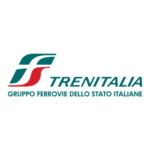
The official apps of Italy’s primary train operators, offering direct booking without commission fees, real-time information about track changes and delays, and access to special promotions not available on third-party platforms. They include detailed information about onboard services and are essential for managing tickets purchased through Italy’s self-service kiosks.
Download From: App Store or visit: Trenitalia
Omio

Formerly GoEuro, this platform seamlessly integrates transportation options across Europe into a single booking process. It’s particularly valuable for travelers in Italy as it connects with smaller regional transport providers that might not have English-language websites. Omio stores all your tickets in one place and sends timely departure alerts, making it especially useful when navigating between multiple Italian cities.
Download From: Play Store or App Store or visit: Omio
Trainline

Beyond simple ticket booking, Trainline provides comprehensive insights into the Italian rail system, distinguishing between the high-speed Frecciarossa/Italo services and regional trains. It offers split-ticket options that can significantly reduce costs on longer journeys and provides platform information and delay notifications. The app also allows offline access to tickets, crucial when traveling through areas with limited connectivity.
Download From: Play Store or App Store or visit: TrainLine
Activities
Tripadvisor

Tripadvisor is a travel guidance platform featuring user-generated reviews and photos of accommodations, restaurants, attractions, and experiences worldwide. The site helps travelers plan trips by providing authentic reviews, price comparisons, and booking options. Tripadvisor’s massive collection of user reviews (over 900 million) makes it a go-to resource for researching destinations and businesses. Beyond reviews, the platform offers forums where travelers can ask questions and get advice from other community members. While originally focused on reviews, Tripadvisor has expanded to include price comparison and direct booking capabilities for hotels, experiences, and restaurants.
Download From: Play Store or App Store or visit: Tripadvisor
GetYourGuide

GetYourGuide is an online marketplace for travel experiences and activities. The platform offers tours, excursions, workshops, and attraction tickets in destinations worldwide. Users can book skip-the-line tickets to popular attractions, guided tours, day trips, cooking classes, and unique local experiences. The service features verified customer reviews, instant confirmations, and flexible cancellation policies. GetYourGuide focuses on curating high-quality experiences and provides a seamless booking process with mobile tickets. The Berlin-based company has become one of the leading platforms for in-destination activities, helping travelers discover and book experiences easily.
Download From: Play Store or App Store or visit: GetYourGuide
Tiqets

Tiqets specializes in digital tickets for museums, attractions, and experiences worldwide. The platform focuses on providing instant ticket delivery and mobile entry for popular attractions, eliminating the need to print physical tickets or wait in ticket lines. Tiqets partners directly with venues to secure official tickets, often with exclusive deals or special access. The service is particularly strong in major European cities and cultural destinations, offering tickets to museums, theme parks, landmarks, and guided tours. Their mobile app serves as both a booking platform and a digital wallet for storing tickets.
Download From: Play Store or App Store or visit: Tiqets
WeGoTrip

WeGoTrip offers self-guided audio tours and walking routes for destinations around the world. Users download tour routes and audio commentary to their smartphones, allowing them to explore cities at their own pace without joining a guided group. The tours combine storytelling, historical context, and practical guidance, created by local experts and professional guides. WeGoTrip’s app works offline once tours are downloaded, eliminating roaming charges. This budget-friendly alternative to traditional guided tours appeals to independent travelers who prefer flexibility in their sightseeing schedule while still benefiting from professional guidance.
Download From: Play Store or App Store or visit: WeGoTrip
Klook

Klook is an activities and services booking platform particularly strong in Asia-Pacific markets. The service offers attraction tickets, tours, local transportation, WiFi rental, and unique experiences ranging from traditional cooking classes to adventure activities. Klook often provides discounted rates compared to walk-up prices and features instant confirmation with QR-code tickets. The platform has expanded globally but maintains its strongest presence in Asian destinations where it offers unique local experiences that might be difficult for international travelers to discover or book independently due to language barriers or local payment requirements.
Download From: Play Store or App Store or visit: Klook
Intui.travel

Intui.travel is a platform specializing in guided tours and unique travel experiences. The service focuses on connecting travelers with knowledgeable local guides who provide authentic insights into destinations. Tours range from traditional sightseeing to specialized themes like food, history, or photography. The platform emphasizes small group sizes and personalized experiences rather than mass tourism. Intuit.travel verifies guides and provides detailed information about tour content, physical requirements, and what’s included. It serves as an alternative to larger tour booking platforms by focusing on quality local experiences with expert guides.
visit: Intui.travel
Visit Tuscany

The official tourism portal for Tuscany goes beyond basic attraction information to provide thematic itineraries based on interests like Renaissance art, Etruscan history, or wine production. The site includes detailed information about lesser-known destinations, seasonal events in small villages, and practical advice about topics like museum reservation systems and restricted traffic zones in historic centers.
Visit: Visit_Tuscany
Cab’s
FREENOW

FREENOW (formerly known as mytaxi) is a mobility service provider operating in Europe. The app allows users to book taxis, private hire vehicles, e-scooters, and e-bikes. FREENOW connects passengers directly with licensed taxi drivers, providing estimated arrival times, fare estimates, and cashless payment options. Users can rate drivers, save favorite addresses, and receive digital receipts. The service operates in over 100 European cities and has expanded beyond traditional taxi services to become a multi-modal mobility platform integrating various transportation options in urban environments.
Download From: Play Store or App Store or visit: FreeNow
Kiwitaxi

Kiwitaxi is an international transfer booking service that arranges private transportation from airports, train stations, or hotels to destinations in over 100 countries. Users can pre-book rides with fixed prices shown upfront in their preferred currency. The service offers various vehicle classes from economy to luxury vans based on passenger count and luggage requirements. Kiwitaxi handles the booking and payment process, while local transportation companies provide the actual service. Drivers typically meet customers with name signs, assist with luggage, and provide door-to-door service, making it particularly useful for travelers seeking hassle-free airport transfers in unfamiliar destinations.
Download From: App Store or visit: Kiwitaxi
Welcome Pickups

Welcome Pickups specializes in personalized airport transfers and travel experiences. The service goes beyond standard transportation by pairing travelers with local, English-speaking drivers who provide insights about the destination. Bookings include meet-and-greet service with drivers tracking flight information for timely pickups, even if flights are delayed. Welcome Pickups differentiates itself by offering fixed prices, personalized welcome kits with useful local information, and the option to add experiences like guided tours to transfers. The service operates in major tourist destinations across Europe, Asia, North America, and Australia.
Download From: Play Store or App Store or visit: Welcome Pickups
Ittaxi

The official app connecting users to licensed taxis across Italy, ensuring travelers use only legitimate services with regulated pricing. The app provides fare estimates based on current traffic conditions, allows specification of special requirements (like extra luggage space or wheelchair accessibility), and enables you to track your assigned taxi’s arrival. It’s particularly valuable in smaller cities where ride-sharing services may not operate.
Download From: Play Store or App Store or visit: itTaxi
Food & Dining
The Fork

A restaurant reservation platform specializing in Italian establishments, with detailed filters for regional cuisines, price ranges, and special dietary requirements. The app provides information about typical dining hours (which vary by region in Italy), offers special promotions, and includes authentic user photos of dishes. It’s particularly useful for securing tables at popular restaurants during peak seasons or festive periods.
Download From: Play Store or App Store or visit: The Fork
Deliveroo

A food delivery service operating in major Italian cities, connecting users with both international chains and local establishments. The app provides estimated delivery times based on current restaurant business, allows customization of orders to accommodate dietary restrictions, and includes specialized filtering for authentic local specialties. Particularly useful during siesta hours when many restaurants close or for dining in after long days of sightseeing.
Download From: Play Store or App Store or visit: Deliveroo
HappyCow

An essential resource for vegetarian and vegan travelers in Italy, a country where traditional cuisine often heavily features meat and cheese. The platform identifies restaurants, cafes, and shops catering to plant-based diets, with user reviews specifically addressing how accommodating establishments are to dietary restrictions. It includes information about organic markets, health food stores, and vegetarian-friendly traditional trattorias.
Download From: Play Store or App Store or visit: HappyCow
Network Provider’s
Vodafone Italy

Vodafone Italy represents the Italian branch of the global Vodafone Group, one of the world’s largest mobile network operators. Think of Vodafone as the established international player that brings global expertise to the Italian market. They operate as a full-service provider offering mobile, fixed-line, and internet services. What makes Vodafone particularly interesting is their strong network infrastructure, which they’ve built over decades of operation. They typically position themselves in the premium segment, focusing on quality coverage and advanced services like 5G deployment. Their customer base tends to include both individual consumers seeking reliable service and businesses requiring robust connectivity solutions.
TIM (Telecom Italia)

TIM (Telecom Italia) serves as Italy’s historical telecommunications giant and former state monopoly. To understand TIM’s role, imagine them as the foundational backbone of Italian telecommunications infrastructure. They evolved from being the country’s sole telephone provider into a modern multi-service operator. TIM maintains the most extensive fixed-line network in Italy, which gives them a unique advantage in providing integrated services that combine mobile and home connectivity. They often leverage this infrastructure advantage to offer bundled packages that competitors find difficult to match. Their brand carries significant recognition among Italian consumers, particularly older demographics who remember when they were the only option available.
Wind Tre

Wind Tre emerged from a fascinating merger story that illustrates how the telecommunications industry consolidates over time. Originally, Wind and 3 Italia (Tre) operated as separate competing networks. Wind brought strong coverage and competitive pricing, while 3 Italia focused on data services and younger demographics. When they merged in 2016, they created Italy’s second-largest mobile operator by combining their strengths. This merger allowed them to compete more effectively against larger rivals by pooling their spectrum resources and infrastructure investments. Wind Tre now positions itself as a value-oriented provider that offers competitive pricing while maintaining reasonable network quality.
Iliad

Iliad represents the newest and most disruptive force in the Italian market, having launched in 2018. To appreciate Iliad’s impact, consider how they operate as a digital-first challenger brand that deliberately breaks traditional telecom pricing models. They gained attention by offering transparent, simple pricing with no hidden fees or complex contract terms. Iliad built their reputation in France by challenging established operators with straightforward offers, and they brought this same approach to Italy. Their strategy focuses on providing excellent value through streamlined operations and efficient network management, often attracting price-conscious consumers who feel frustrated with traditional carriers’ complexity.
Yesim

Digital eSIM provider specializing in travel connectivity solutions. Offers the convenience of instant activation without physical SIM cards. Popular with tech-savvy tourists who have eSIM-compatible devices. Provides flexible short-term plans specifically designed for visitors.
Download From: Play Store or App Store or visit: yeSim
Miscellaneous
Radical Storage
On-demand luggage storage network with verified locations in cities worldwide. Book secure storage by the day for hassle-free sightseeing without heavy bags.
Download From: Play Store or App Store or visit: Radical Storage
Compensair

Flight compensation service that helps travelers claim money for delayed or canceled flights under EU regulations. Simple process with no upfront fees.
visit: Compensair
AccuWeather

AccuWeather is a weather forecasting service providing detailed weather information for locations worldwide. The platform offers current conditions, hourly forecasts, and extended predictions up to 45 days. AccuWeather’s MinuteCast feature provides minute-by-minute precipitation forecasts for the next two hours. The service includes air quality information, allergy reports, radar and satellite imagery, and severe weather alerts. AccuWeather distinguishes itself through its AccuWeather Superior Accuracy™ forecasting methodology, which combines meteorological data, proprietary algorithms, and human forecaster expertise to provide highly accurate weather predictions.
Download from: Play store or App Store or visit: AccuWeather
EasyPark

EasyPark is a mobile parking payment application operating in hundreds of cities across Europe and Australia. The app allows drivers to pay for parking digitally without needing physical tickets or coins for parking meters. Users can start, extend, or stop parking sessions remotely through the app, paying only for the exact time used. EasyPark provides features like parking spot finding, reminder notifications before parking expires, and digital receipts for expense reporting. The service has expanded to include electric vehicle charging payments in some markets. EasyPark simplifies urban parking through digital payment and management of parking sessions.
Download From: Play Store or App Store or visit: EasyPark
Duolingo

Duolingo is a language learning platform offering courses in over 40 languages through gamified lessons. The app breaks language learning into short, interactive exercises focusing on reading, writing, listening, and speaking skills. Duolingo uses spaced repetition techniques to optimize vocabulary retention and implements game elements like points, levels, and streaks to maintain user motivation. The platform employs a freemium model with optional subscription removing advertisements and adding features like offline learning. Duolingo’s approach makes language learning accessible to beginners and provides a structured path from basic phrases to more complex language constructions through regular, bite-sized practice sessions.
Download From: Play Store or App Store or visit: Duolingo
Google Maps

Google Maps is the world’s most widely used mapping and navigation service. It provides detailed maps, satellite imagery, street view perspectives, real-time traffic information, and navigation for driving, walking, cycling, and public transportation. The app integrates business listings, reviews, and photos, making it useful for discovering local establishments. Google Maps offers features like offline maps, location sharing, and saved places. Its strength lies in comprehensive global coverage, frequent updates, accurate traffic predictions based on historical data and real-time information, and integration with other Google services.
Download From: Play Store or App Store or visit: Maps
Google Translate

Google Translate is a multilingual machine translation service that can translate text, documents, websites, and even images containing text between over 100 languages. The app offers features like conversation mode for real-time speech translation, camera translation for instantly translating text in images, and offline translation capabilities for selected languages. While not always perfect, particularly for complex or idiomatic language, Google Translate serves as an invaluable tool for travelers, language learners, and international communication. It uses neural machine translation technology to provide increasingly natural-sounding translations.
Download From: Play Store or App Store or visit: Translate
Citymapper

Citymapper is a public transit and mapping service that combines all urban mobility options into one app. Unlike traditional mapping services, Citymapper specializes in complex urban environments and offers detailed transit directions including subways, buses, trains, ferries, ride-sharing, bike-sharing, and walking. The app provides real-time departures, service disruption alerts, and even calorie counts for walking routes. It excels in showing multiple route options with accurate time estimates and step-by-step navigation. Originally launched in London, it now covers major cities worldwide and is particularly valued by travelers and new residents unfamiliar with local transit systems.
Download From: Play Store or App Store or visit: Citymapper
SkylineWebcams

Offers live video feeds from cameras positioned at major Italian landmarks, piazzas, and scenic viewpoints. Beyond satisfying curiosity, these webcams provide practical information about current weather conditions, crowd levels at popular attractions, and the status of outdoor events. Particularly useful for checking snow conditions in mountain areas or beach crowds along the coast.
Visit: Skyline
TripIt

A comprehensive travel organizer that consolidates all reservations, tickets, and itineraries into a single chronological timeline. The service automatically updates flight information, provides transportation time estimates between locations, and stores digital copies of travel documents. Its sharing functionality allows multiple travelers to access the same itinerary, particularly useful for group travel in Italy.
Download From: Play Store or App Store or visit: Tripit


